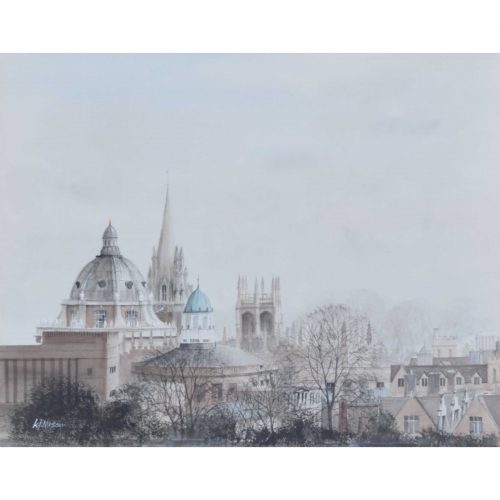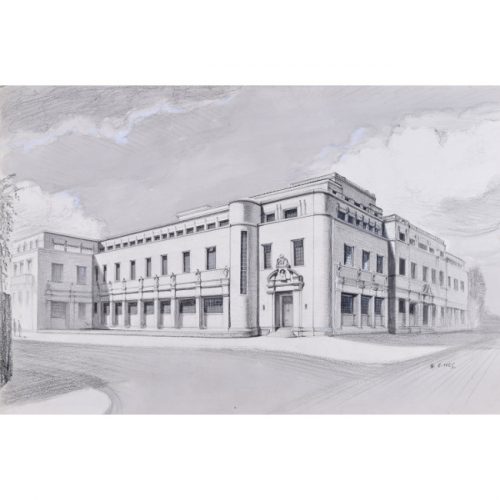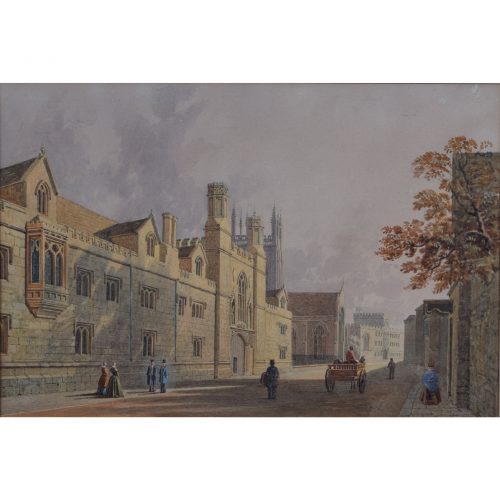-
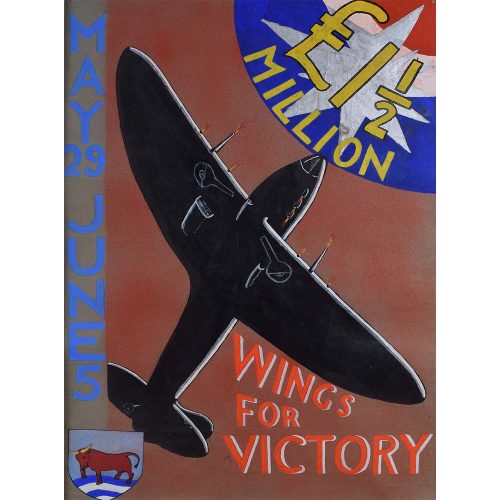
Anonymous
Oxford Wings for Victory Poster Design
56x38cm 62x44cm including hand-finished black frame. Gouache on paper c. 1943 Click here to see other posters from this series and for more information on Wings for Victory campaigns. If you are interested email info@manningfineart.co.uk or call us on 07929 749056. Condition: excellent, framed. -
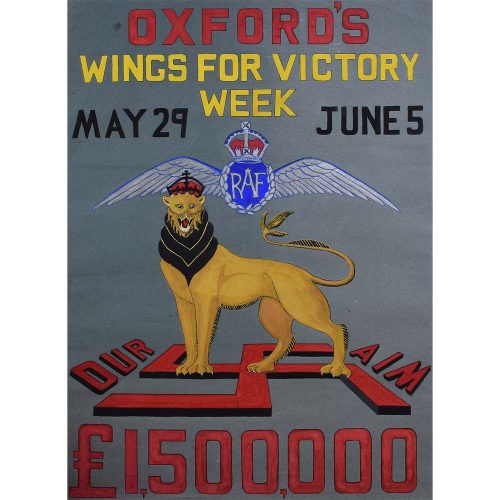
Anonymous
Oxford Wings for Victory Poster Design IV
c.1943 Gouache on paper 70 x 51 cm 89 x 68 cm including hand-finished frame, UK shipping only Click here to see other posters from this series. If you are interested email info@manningfineart.co.uk or call us on 07929 749056. Condition: Excellent. -
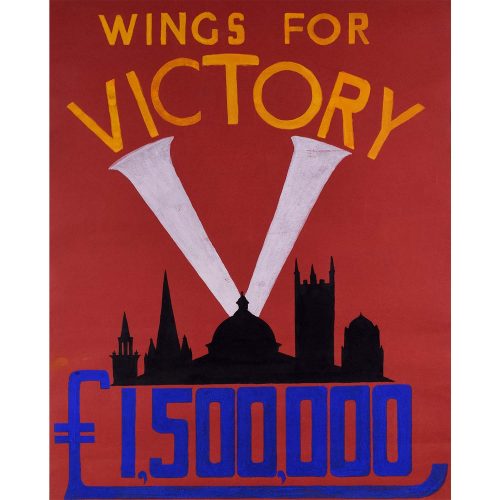
Anonymous
Oxford Wings for Victory Poster Design II
c.1943 Gouache on paper 63 x 50 cm 81x66cm including hand-finished frame, UK shipping only Click here to see other posters from this series. If you are interested email info@manningfineart.co.uk or call us on 07929 749056. Condition: Excellent. -
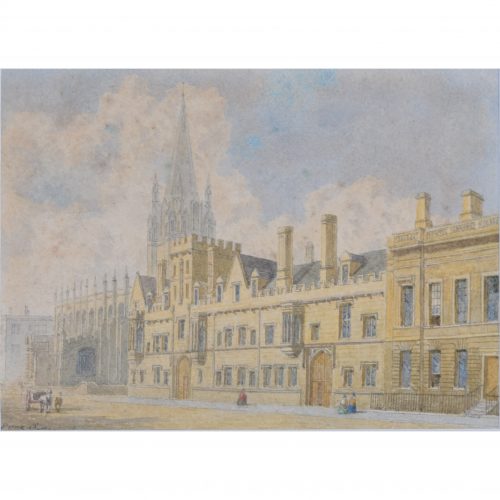
George Pyne (1800 - 1884) The High, Oxford
Watercolour 15 x 21 cm Signed and dated indiscriminately lower left. A 19th-century view of the High Street, Oxford. The spire of the University Church of St Mary the Virgin towers over the street; a horse and cart and brightly-dressed pedestrians pass by. George Pyne was related to two founders of the Society of Painters in Watercolours – William Henry Pyne was his father, and John Varley his father-in-law. Pyne trained as an architectural draughtsman and lived in Oxford from the 1850s until his death in 1884, specialising in views of the city and its colleges. His Oxford pictures are both architecturally-minded and romantically creative, often combining intensely detailed depictions of college buildings with imagined pedestrian scenes. Pyne was also noted for his views of Cambridge and Eton, and for his drawing manuals ‘A Rudimentary and Practical Treatise on Perspective for Beginners’ (1848) and ‘Practical Rules on Drawing for the Operative Builder, and Young Student in Architecture’ (1854); the latter texts offer an insight into his method of depicting architecture and its surroundings. Condition: generally good; some spotting and toning to sky. If you’d like to know more, please email info@manningfineart.co.uk or call us on 07929 749056. -
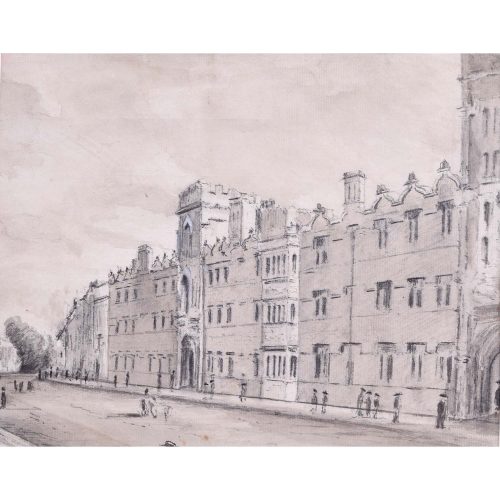
Anonymous
Oxford High Street (c.1840)
Pencil & wash on paper 18x23cm If you are interested email info@manningfineart.co.ukor call us on 07929 749056. Condition: Good. -

Pieter van der Aa (1659-1733), after David Loggan (1634–1692)
Oxford from the East (1727)
Engraving 12 x 16 cm An eighteenth-century view of Oxford from the east, engraved by Pieter van der Aa after David Loggan, the noted engraver, draughtsman, and painter. The skies are wide and full of the University's dreaming spires. Pieter van der Aa of Leiden was a Dutch publisher best known for preparing maps and atlases, though he also printed editions of foreign bestsellers and illustrated volumes. He is noted for the many engravings he produced after David Loggan's series of Oxford and Cambridge colleges and costumes. In 1727 Van Der Aa illustrated "Les Delices de la Grande Bretagne & de L'Irelande" by James Beeverell, the book in which this engraving appears. Condition: a good impression. If you’d like to know more, please email info@manningfineart.co.uk or call us on 07929 749056. -
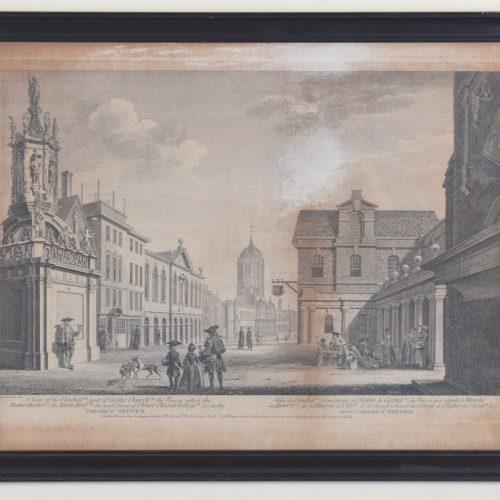
John Donowell (flourished 1753 - 1786) A View of the Conduit part of Carfax Church, the Piazza called the Butter Market, the Town Hall, the West Front of Christ Church College, &c. in the University of Oxford (1750)
Engraving 29 x 42 cm An eighteenth century view of St Aldate''s, featuring the west front of Christ Church and the Town Hall. Undergraduates, academics, and townspeople saunter along, all under the watchful eye of Tom Tower. John Donowell was an eighteenth-century British architect and engraver, considered to be one of the principal architect-draughtsmen in the latter part of the eighteenth century. He exhibited in 1761 at the Free Society, then through the 1760s at the Society of Artists, and from 1778 to 1786 at the Royal Academy; prints, some hand-coloured, were published at this time. Condition: some browning; antique frame with old glass. If you’d like to know more, please email info@manningfineart.co.uk or call us on 07929 749056. -
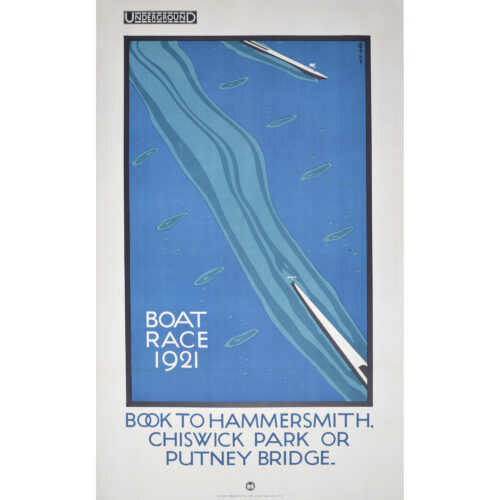
Charles Paine (1895 - 1967)
Boat Race 1921
Lithograph 102 x 64 cm Signed upper right in plate. Charles Paine's iconic 1921 poster encourages the use of the London Underground in order to view the Boat Race. The slick design features one boat’s stern disappearing from the frame and the other boat’s bow entering it (Cambridge won that year), alongside a strikingly Art Deco typeface. Charles Paine was a versatile and prolific designer, who drew on his training in stained glass to create bold, structured and highly stylised lithographs for a variety of companies. This decorative and brightly-coloured map illustrates the various county regiments of Great Britain, with a border of regimental badges. Condition: backed to linen; excellent, two small areas of repair to margin (invisible); hint of old folds. If you are interested, please email info@manningfineart.co.uk or call us on 07929 749056. Click here for other Boat Race pictures. -

after Edward Dayes (1763 - 1804)
Oxford (1792)
Hand-coloured engraving 15 x 20 cm Published February 1st 1792 by Harrison & Co, Paternoster Row. A charmingly-coloured Oxford punting scene, with Magdalen Tower and other dreaming spires behind. Edward Dayes was an English watercolour painter and mezzotint engraver. He first exhibited at the Royal Academy in 1786, when he showed a portrait and views of Waltham Cross and Canterbury. In the three following years he exhibited both miniatures and landscapes. He continued to exhibit at the Academy regularly until the year of his death, contributing a total of 64 works. He also exhibited at the Society of Artists, and worked as draughtsman to the Duke of York and Albany. Condition: very good. If you’d like to know more, please email info@manningfineart.co.uk or call us on 07929 749056. Click here for other general views of Oxford. -
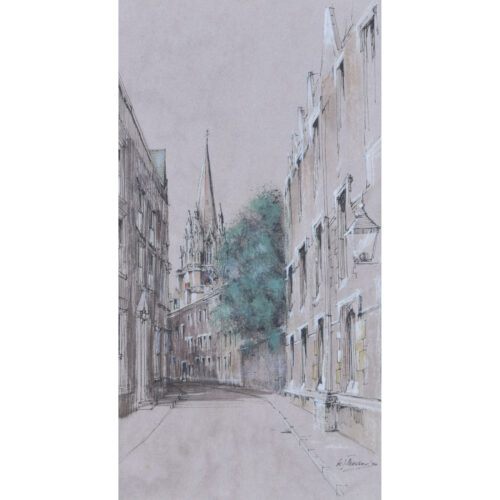
Ken Messer (1931 - 2018)
Oriel Street (1974)
Watercolour 39 x 21 cm Signed and dated lower right. The painter and draughtsman Ken Messer is closely related to Oxford and its architecture in several ways. Born in Newport, South Wales, he was educated at the City of Oxford High School for Boys in Oxford, and then spent six years working as an accountant in Oxford. He then joined British Overseas Airways Corporation (BOAC) as a steward, flying internationally. Injury due to a car accident during the 1960s meant that he joined the design department of Pergamon Press in Oxford at the age of 33. Six years later, he was appointed to the position of studio manager, in charge of art and design. In 1974, Messer left Pergamon Press to become a freelance graphic designer. He started painting more watercolours, becoming a full-time artist. During the 1980s, his ink drawings were regularly published in the Oxford Times. He has sometimes been called "The Oxford Artist" because of his large number of works depicting Oxford. He and his wife Dilys lived at first in Richmond upon Thames and then in Abingdon, just south of Oxford. Messer's work has been shown at the Mall Galleries for the annual exhibitions of the Royal Institute of Painters in Water Colours annual exhibitions. Condition: very good. If you are interested, please email info@manningfineart.co.uk or call us on 07929 749056. Click here for other views of Oxford. -
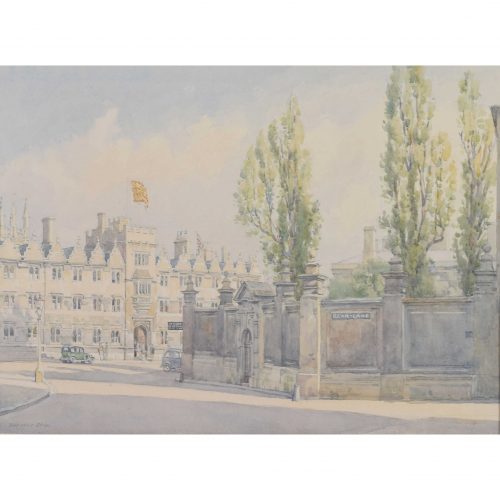
Bernard Cecil Gotch (1876-1964)
Oriel Square, Oxford, at the entrance to Bear Lane
Watercolour 27 x 36.5 cm Signed in pencil lower left. Oriel Square in the afternoon. Two undergraduates lean against the walls of Oriel College, talking, and another group make their way inside. Vintage cars (dating the picture to the 1920s, or 1930s?) are parked outside its gates, and the Oriel flag flies high. Bernard Cecil Gotch was a Winchester-born artist who is best known for his atmospheric watercolours of Britain's towns and cities (most notably Oxford). He moved to Oxford in 1927, painting many watercolours of the interiors and exteriors of Oxford’s many buildings. His works concentrate on the grand exteriors and interiors of the University's colleges, and he exhibited frequently - including an exhibition every term at Oriel College. His first notable commission was for the publisher Methuen, illustrating 'A Shepherd’s Life' by W H Hudson. Whilst in London he was invited to illustrate a book on the Public Schools of England (which was sadly never completed). He exhibited watercolours at the Fine Art Society and Lincolns Inn, and also exhibited at the Royal Academy. In 1952 Gotch was given an Honorary MA by the University of Oxford, and, after his death in 1963, a memorial was held for him at Oriel. Condition: very good. If you’d like to know more, please email info@manningfineart.co.uk or call us on 07929 749056. -
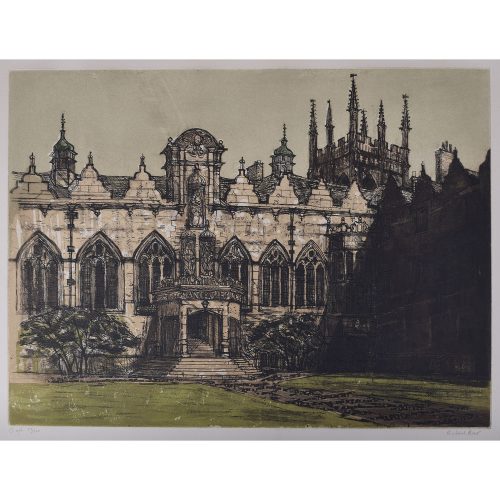
Richard Beer (1928 - 2017) Oriel College, Oxford
Etching 47 x 61 cm Titled and numbered 39/100 lower left, and signed lower right, all in pencil. Condition: very good. If you are interested, please email info@manningfineart.co.uk or call us on 07929 749056. Click here for other views of Oriel College, Oxford. -
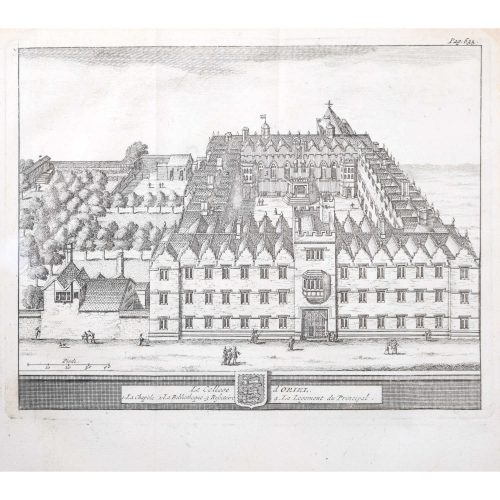
Pieter van der Aa (1659-1733), after David Loggan (1634–1692)
Oriel College, Oxford (1727)
Engraving 12 x 16 cm An eighteenth-century view of Oriel College, engraved by Pieter van der Aa after David Loggan, the noted engraver, draughtsman, and painter. Pieter van der Aa of Leiden was a Dutch publisher best known for preparing maps and atlases, though he also printed editions of foreign bestsellers and illustrated volumes. He is noted for the many engravings he produced after David Loggan's series of Oxford and Cambridge colleges and costumes. In 1727 Van Der Aa illustrated "Les Delices de la Grande Bretagne & de L'Irelande" by James Beeverell, the book in which this engraving appears. Condition: a good impression. If you’d like to know more, please email info@manningfineart.co.uk or call us on 07929 749056. -
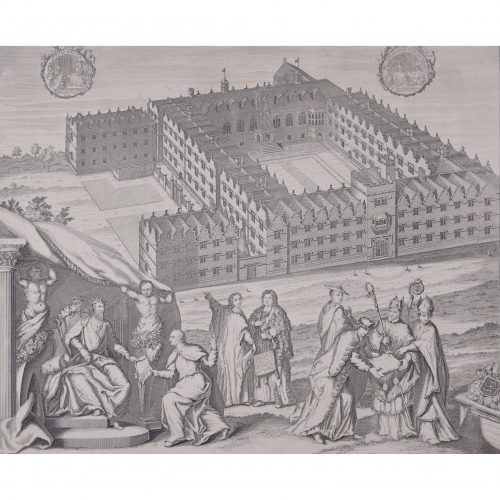
Oriel College, Oxford (1736)
Engraving 35 x 43 cm This fantasia on Oriel, featuring a sublime rendering of the College's architecture and a parade of sound Oriel men, was featured in the 1736 edition of the Oxford Almanack. The Oxford Almanack was an annual almanack published by the Oxford University Press for the University of Oxford from 1674 through 2019 (when printing sadly ceased due to "dwindling interest"). The almanack traditionally included engravings or lithographs of the University and information about the upcoming year. Other almanack artists have included Michael Burghers, J. M. W. Turner, and John Piper. Basire and Dayes collaborated on several views of Oxford during the courses of their careers. Floreat Oriel! Condition: good. Trimmed. If you’d like to know more, please email info@manningfineart.co.uk or call us on 07929 749056. Click here for more views of Oriel. -
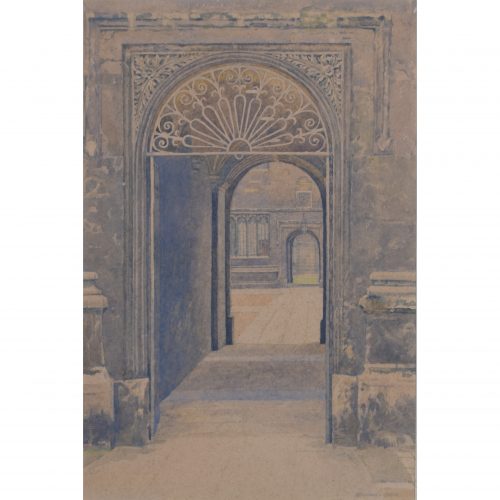
Bernard Cecil Gotch (1876-1964)
The Bodleian Library, Oxford: Passageway into the Old Schools Quandrangle
Watercolour 49 x 35 cm Signed in pencil lower right. An enticing view of the passageway leading into the Old Schools Quad of the Bodleian Library. Through the gateway, we see the passageway leading out of the Quad onto the other side, into Radcliffe Square. A glimpse of the Radcliffe Camera, surrounded by its green lawn, is visible through the two passages. Bernard Cecil Gotch was a Winchester-born artist who is best known for his atmospheric watercolours of Britain's towns and cities (most notably Oxford). He moved to Oxford in 1927, painting many watercolours of the interiors and exteriors of Oxford’s many buildings. His works concentrate on the grand exteriors and interiors of the University's colleges, and he exhibited frequently - including an exhibition every term at Oriel College. His first notable commission was for the publisher Methuen, illustrating 'A Shepherd’s Life' by W H Hudson. Whilst in London he was invited to illustrate a book on the Public Schools of England (which was sadly never completed). He exhibited watercolours at the Fine Art Society and Lincolns Inn, and also exhibited at the Royal Academy. In 1952 Gotch was given an Honorary MA by the University of Oxford, and, after his death in 1963, a memorial was held for him at Oriel. Condition: very good. Framed, with washline mount. If you’d like to know more, please email info@manningfineart.co.uk or call us on 07929 749056. -
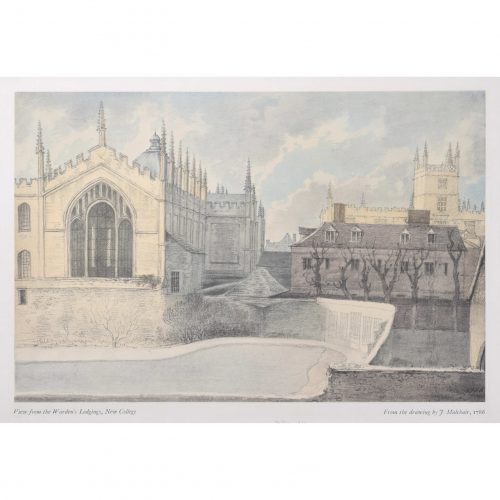
John Baptist Malchair (1730 – 1812)
View from the Master's Lodgings, New College, Oxford (1929)
Lithograph 33 x 46 cm A 1929 lithograph from a 1767 watercolour of New College by John Malchair. The artist's composition highlights the pale stone of New College on a winter's day. The chapel's spires stretch upward into a cold, cloud-filled sky, as do the bare branches of the trees. Malchair's watercolour (which is held by the Ashmolean museum) was reproduced as a lithograph in 1929, to be published in the "Oxford Almanack". The Oxford Almanack was an annual almanac published by the Oxford University Press for the University of Oxford from 1674 through 2019 (when printing sadly ceased due to "dwindling interest"). The almanac traditionally included engravings or lithographs of the University and information about the upcoming year. Other almanac artists have included James Basire, Michael Burghers, J. M. W. Turner, and John Piper. Malchair was a German-born watercolourist, violinist, drawing master, and collector of traditional European music. He is described as “one of the most distinctive figures of eighteenth century Oxford”, and is recognised as having been an influence on later landscape artists, including John Constable. Malchair was a talented artist, producing hundreds of paintings of English landscapes. His legacy is the collection of hundreds of sketches and watercolours of historical, architectural and topographical interest, particularly of Oxford's medieval buildings. Condition: very good. If you’d like to know more, please email info@manningfineart.co.uk or call us on 07929 749056. -
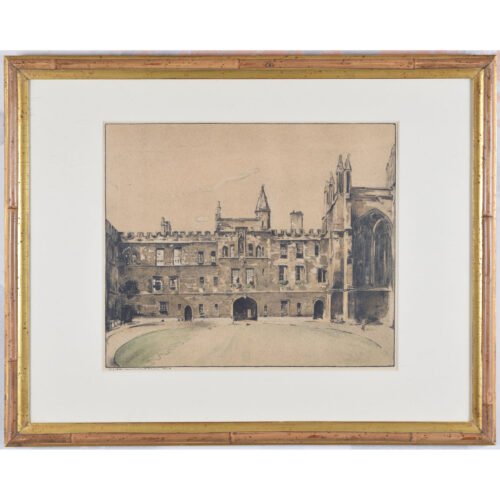
William Nicholson (1872 - 1949)
New College, Oxford
Lithograph 29 x 35 cm Signed lower left and numbered 10. Between 1902 and 1904 William Nicholson lived in Woodstock; during this period he made several architectural studies of Oxford's colleges and other University buildings. Sir William Nicholson was a British painter and printmaker. He is also known as an illustrator, author of children’s books, stained glass designer, and theatre set designer. Condition: very good. In handsome faux-bamboo gilt frame. If you are interested, please email info@manningfineart.co.uk or call us on 07929 749056. Click here for other views of Queen's College, Oxford. -
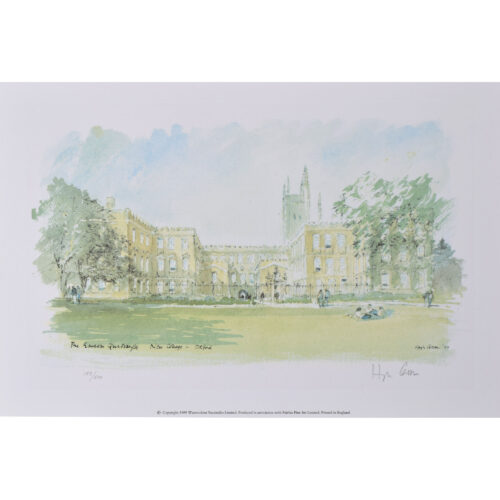
Hugh Casson (1910 - 1999)
The Garden Quadrangle, New College, Oxford (1989)
Lithograph 25 x 39 cm Signed, titled and dated in plate, and numbered 153/500 and signed lower right in pencil. Casson's view of New College's Garden Quad, complete with picnicking undergraduates. Sir Hugh Casson was educated at Eastbourne College; St John’s College, Cambridge; and the Bartlett School of Architecture. Trained in the 1930s in the early modernist style, he taught at the Cambridge School of Architecture. After employment as a camoufleur during World War 2 by the Air Ministry, in 1948 he was appointed as director of architecture for the Festival of Britain. A close friend of the Royal Family, he undertook designs for the 1953 coronation, designed the interior of the Royal Yacht Britannia (“The overall idea was to give the impression of a country house at sea”), and taught the young Charles III to paint in watercolours. Amongst his architectural achievements are the Elephant House at London Zoo, the 1978 redevelopment of Bristol Docks, the Raised Faculty Building for The University of Cambridge, and a building for the Royal College of Art. He published a number of illustrated books, of which Casson’s Oxford and Casson’s Cambridge are probably the best known. A limited edition series of prints was produced from the paintings. Condition: generally very good. If you’d like to know more, please email info@manningfineart.co.uk or call us on 07929 749056. Click here for other views of New College, Oxford. -
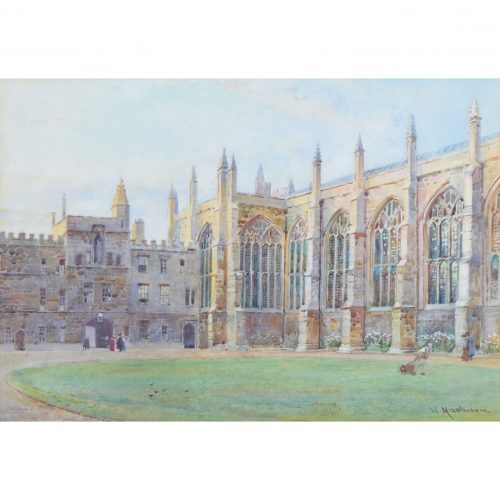
William Matthison (1853-1926)
New College, Oxford: Front Quad
Watercolour 35 x 52 cm Signed lower right. A charming watercolour of New College's Front Quad complete with members of the college in academic dress, wandering birds, and a gardener mowing the grass. William of Wykeham, who founded New College in 1379, was an ambitious builder. His vision for the college was of a Chapel, Hall, Library, and rooms for tutors and students to work and live in, all of which would be built around a quadrangle. This was the first time a college had been set in this way, and it became a model for colleges worldwide. Matthison was born near Birmingham and attended King Edward’s School in the city. He learnt drawing at the Birmingham Central School of Art and then became a pupil of Birmingham artist Edward Watson. He became a professional artist in 1875 and moved to Oxfordshire a few years after; this was where he had the opportunity to produce many of the Oxford views for which he is known today. In 1902 he moved to Park Town in Oxford and was commissioned by Robert Peel to paint more than seventy views of the University of Oxford, which were subsequently made into postcards. Priced at seven for a shilling, they were only available from E Cross of Pembroke Street (a long-since closed business). Raphael Tuck & Sons also commissioned him to produce postcard scenes of Cambridge. Matthison’s views of Oxford were later printed in Fifty Watercolour Drawings of Oxford, published in 1912 by Alden & Co. Condition: generally very good; a few spots to sky. If you are interested, please email info@manningfineart.co.uk or call us on 07929 749056. Click here for other views of New College, Oxford. -
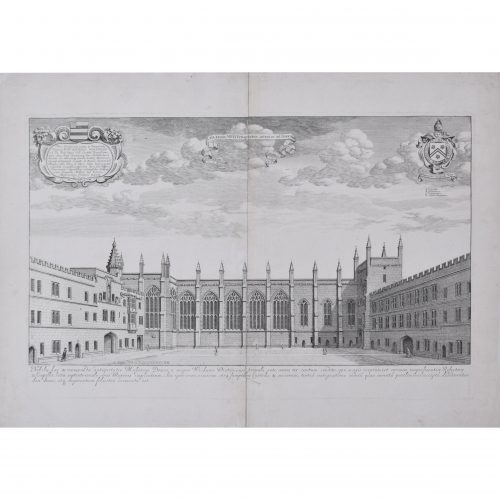
David Loggan (1634 - 1692)
New College, Oxford (1705)
Engraving 31 x 49 cm Loggan was born to English and Scottish parents, and was baptised in Danzig in 1634. After studying engraving in Danzig with Willem Hondius (1598-1652 or 1658), he moved to London in the late 1650s, going on to produce the engraved title-page for the folio 1662 Book of Common Prayer. He married in 1663 and moved to Nuffield in Oxfordshire in 1665. Loggan was appointed Public Sculptor to the nearby University of Oxford in the late 1660s, having been commissioned to produce bird’s-eye views of all the Oxford colleges. He lived in Holywell Street as he did this. The 'Oxonia Illustrata' was published in 1675, with the help of Robert White (1645 - 1704). Following its completion, Loggan began work on his equivalent work for Cambridge; the 'Cantabrigia Illustrata' was finally published in 1690, when he was made engraver to Cambridge University. The 'Oxonia Illustrata' also includes an engraving of Winchester College (Winchester and New College share William of Wykeham as their founder) whilst the 'Cantabrigia Illustrata' includes one of Eton College (which shares its founder, Henry VIII, with King’s College). Bird’s-eye views from this era required a particular talent as an architectural perspectivist; it was not until 1783 that it became possible for artists to ascend via hot air balloons and view the scenes they were depicting from above. Loggan thus had to rely on his imagination in conceiving the views. Loggan’s views constitute the first accurate depictions of the two Universities, in many ways unchanged today. Whilst the Oxford engravings were produced in reasonable numbers and ran to a second edition by Henry Overton (on thicker paper and with a plate number in Roman numerals in the bottom right-hand corner), those of Cambridge were printed in much smaller numbers. The Dutchman Pieter van der Aa published some miniature versions of the engravings for James Beverell’s guidebook to the UK, 'Les Delices de la Grande Bretagne' (circa 1708). The contemporary artist Andrew Ingamells has produced a highly-acclaimed series of etchings which bring Loggan’s original vision up to date. Condition: repaired tear to central fold; has been washed. If you’d like to know more, please email info@manningfineart.co.uk or call us on 07929 749056. -
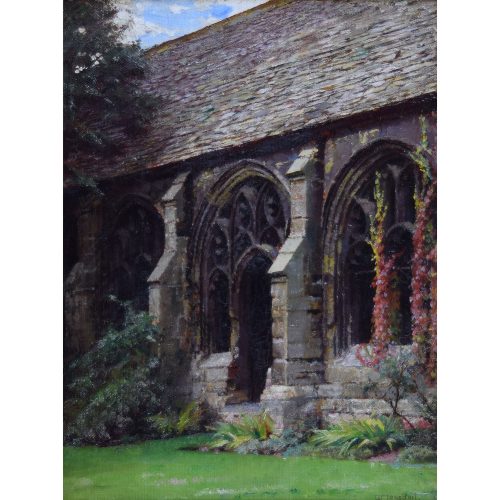
William Logsdail (1859-1944)
Cloisters of New College, Oxford
Oil on board 39 x 28 cm Signed lower right. In original Watts-style gilt frame. Logsdail was educated at Lincoln Cathedral School and then Lincoln School of Art. Initially intending to become an architect, he was encouraged to divert his attentions to painting. After winning a Gold Medal in a competition against students of other English art schools, Logsdail continued his painting career at the Ecole des Beaux Arts in Antwerp. His promise was recognised by the Royal Household when his 1880 picture The Fish Market was purchased for Osborne House. Logsdail went on to spend the next twenty years in Venice, studying and painting the city's architecture. His 1883 rendering of the Piazza of St Mark's, Venice, was named by the Royal Academy as picture of the year. He also spent time painting the colleges of Oxford and Cambridge. In 1912, having moved away from architectural painting and towards portraiture, he was elected to the Society of Portrait Painters. He settled in Oxfordshire in 1922. If you are interested, please email info@manningfineart.co.uk or call us on 07929 749056. Click here for other views of New College, Oxford. -
Out of stock
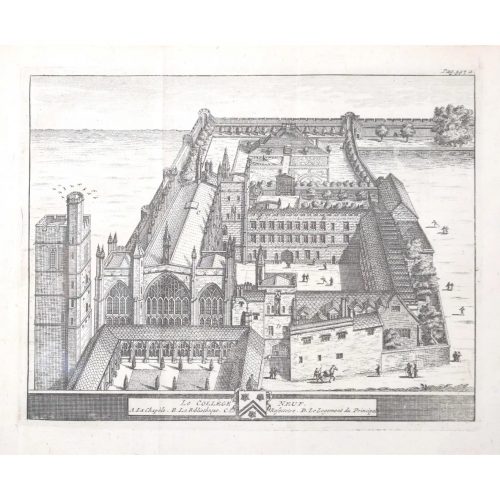
Pieter van der Aa (1659-1733), after David Loggan (1634–1692)
New College, Oxford (1727)
Engraving 12 x 16 cm An eighteenth-century view of Le College Neuf (New College), engraved by Pieter van der Aa after David Loggan, the noted engraver, draughtsman, and painter. Founded in 1379 by William of Wykeham, New College is one of the oldest colleges at the university and was the first to admit undergraduate students. Architecturally, New College was innovative in its design, in that it was all planned around an enclosed quadrangle (finished 1386). This was the first quadrangle of its type, though it has since become one of the defining features of colleges across Oxford and Cambridge. Pieter van der Aa of Leiden was a Dutch publisher best known for preparing maps and atlases, though he also printed editions of foreign bestsellers and illustrated volumes. He is noted for the many engravings he produced after David Loggan's series of Oxford and Cambridge colleges and costumes. In 1727 Van Der Aa illustrated "Les Delices de la Grande Bretagne & de L'Irelande" by James Beeverell, the book in which this engraving appears. Condition: a good impression. If you’d like to know more, please email info@manningfineart.co.uk or call us on 07929 749056. -
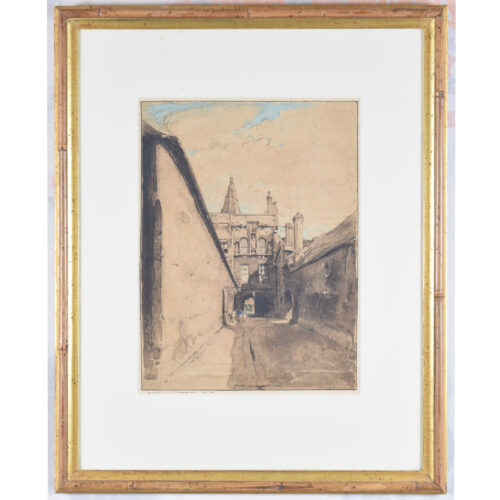
William Nicholson (1872 - 1949)
New College Lane, Oxford
Lithograph 35 x 28 cm Signed lower left and numbered 10 in ink. Between 1902 and 1904 William Nicholson lived in Woodstock; during this period he made several architectural studies of Oxford's colleges and other University buildings. Sir William Nicholson was a British painter and printmaker. He is also known as an illustrator, author of children’s books, stained glass designer, and theatre set designer. Condition: very good. If you are interested, please email info@manningfineart.co.uk or call us on 07929 749056. Click here for other pictures of New College, Oxford. -
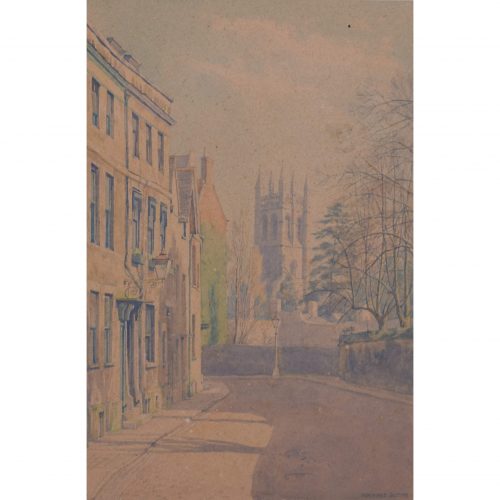
Bernard Cecil Gotch (1876 - 1964)
Merton Street, Oxford
Watercolour 37 x 25.5 cm Signed in pencil lower right. A wintry view of Holywell Street, Oxford, where Charles Ryder and Sebastian Flyte famously take up lodgings in Brideshead Revisited. Magdalen Tower peeps out over the cobbled lane. On the other side of the wall is the Fellows Garden of Merton College. Bernard Cecil Gotch was a Winchester-born artist who is best known for his atmospheric watercolours of Britain's towns and cities (most notably Oxford). He moved to Oxford in 1927, painting many watercolours of the interiors and exteriors of Oxford’s many buildings. His works concentrate on the grand exteriors and interiors of the University's colleges, and he exhibited frequently - including an exhibition every term at Oriel College. His first notable commission was for the publisher Methuen, illustrating ''A Shepherd’s Life'' by W H Hudson. Whilst in London he was invited to illustrate a book on the Public Schools of England (which was sadly never completed). He exhibited watercolours at the Fine Art Society and Lincolns Inn, and also exhibited at the Royal Academy. In 1952 Gotch was given an Honorary MA by the University of Oxford, and, after his death in 1963, a memorial was held for him at Oriel. Condition: slight discolouration to paper. If you’d like to know more, please email info@manningfineart.co.uk or call us on 07929 749056. -
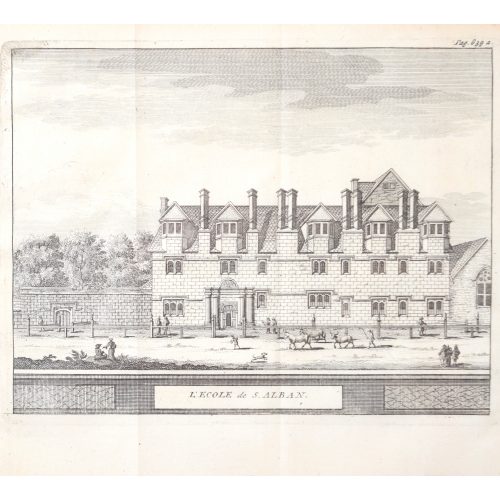
Pieter van der Aa (1659-1733), after David Loggan (1634–1692)
St Alban Hall, Oxford - now Merton College (1727)
Engraving 12 x 16 cm St Alban Hall, sometimes known as St Alban's Hall or Stubbins, was one of the medieval halls of the University of Oxford, and one of the longest-surviving. It was established in the 13th century and was acquired by neighbouring Merton College in the 16th century. The institutions formally merged in the late 19th century. The site in Merton Street, Oxford, is now occupied by Merton's Edwardian St Alban's Quad. Engraved by Pieter van der Aa after David Loggan, the noted engraver, draughtsman, and painter. Pieter van der Aa of Leiden was a Dutch publisher best known for preparing maps and atlases, though he also printed editions of foreign bestsellers and illustrated volumes. He is noted for the many engravings he produced after David Loggan's series of Oxford and Cambridge colleges and costumes. In 1727 Van Der Aa illustrated "Les Delices de la Grande Bretagne & de L'Irelande" by James Beeverell, the book in which this engraving appears. Condition: a good impression. If you’d like to know more, please email info@manningfineart.co.uk or call us on 07929 749056. -
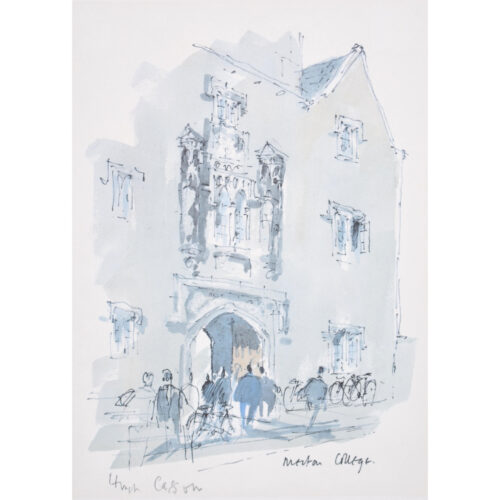
Hugh Casson (1910 - 1999)
Merton College, Oxford
Lithograph 24 x 17 cm Titled in plate lower right and signed in pencil lower left. Casson's blue-toned view of Merton, complete with strolling undergraduates and leaning bicycles. Sir Hugh Casson was educated at Eastbourne College; St John’s College, Cambridge; and the Bartlett School of Architecture. Trained in the 1930s in the early modernist style, he taught at the Cambridge School of Architecture. After employment as a camoufleur during World War 2 by the Air Ministry, in 1948 he was appointed as director of architecture for the Festival of Britain. A close friend of the Royal Family, he undertook designs for the 1953 coronation, designed the interior of the Royal Yacht Britannia (“The overall idea was to give the impression of a country house at sea”), and taught the young Charles III to paint in watercolours. Amongst his architectural achievements are the Elephant House at London Zoo, the 1978 redevelopment of Bristol Docks, the Raised Faculty Building for The University of Cambridge, and a building for the Royal College of Art. He published a number of illustrated books, of which Casson’s Oxford and Casson’s Cambridge are probably the best known. A limited edition series of prints was produced from the paintings. Condition: very good. If you’d like to know more, please email info@manningfineart.co.uk or call us on 07929 749056. Click here for other views of Merton College, Oxford. -
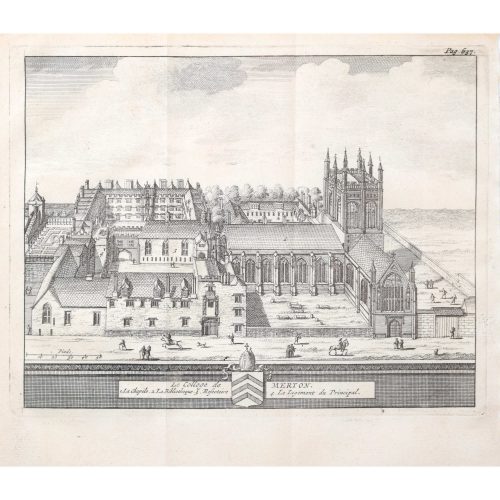
Pieter van der Aa (1659-1733), after David Loggan (1634–1692)
Merton College, Oxford (1727)
Engraving 12 x 16 cm An eighteenth-century view of Merton College, engraved by Pieter van der Aa after David Loggan, the noted engraver, draughtsman, and painter. Pieter van der Aa of Leiden was a Dutch publisher best known for preparing maps and atlases, though he also printed editions of foreign bestsellers and illustrated volumes. He is noted for the many engravings he produced after David Loggan's series of Oxford and Cambridge colleges and costumes. In 1727 Van Der Aa illustrated "Les Delices de la Grande Bretagne & de L'Irelande" by James Beeverell, the book in which this engraving appears. Condition: a good impression. If you’d like to know more, please email info@manningfineart.co.uk or call us on 07929 749056. -
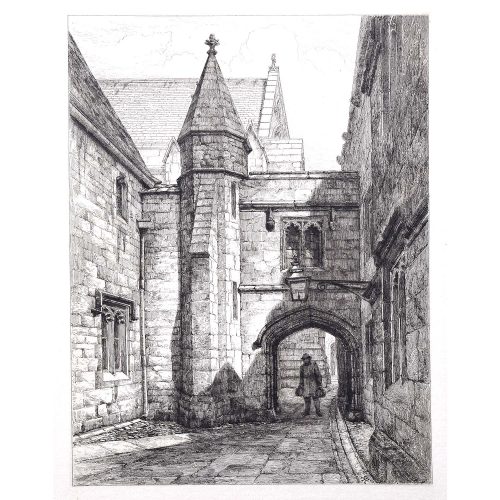
Robert Kent Thomas (1816-1884)
Merton College Oxford
Etching, pubished 1879 21.5x16.5cm If you are interested email info@manningfineart.co.uk or call us on 07929 749056. Condition: Good, mounted to board. -
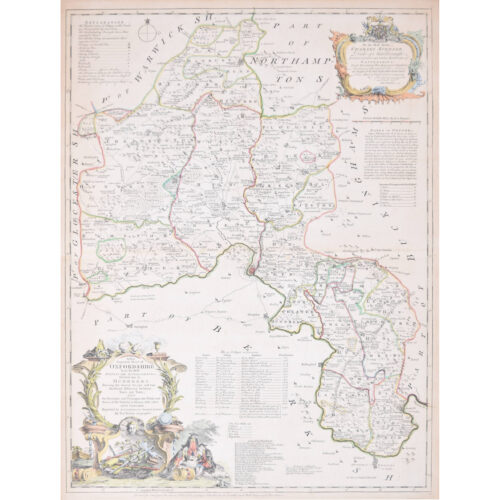
Thomas Kitchin (1719 - 1784)
Map of Oxfordshire (1764)
Engraving with later hand-colouring 72 x 54 cm This decorative map of Oxfordshire features a cartouche with three concentrating scholars and various educational trappings like rolls of parchment. The cartouche in the upper right corner dedicates the map to Charles Spencer, Duke of Marlborough, whose family seat of Blenheim Palace is just outside the city of Oxford. The map also sports a list of the University of Oxford's colleges, its rectories and vicarages, and a paragraph on the Earls of Oxford. Thomas Kitchin was an English engraver and cartographer. He was born in London and was apprenticed to the map engraver Emanuel Bowen in 1732. He produced John Elphinstone's map of Scotland (1746), the Geographia Scotiae (1749), and The Small English Atlas (1749) with Thomas Jefferys. Kitchen worked for the London Magazine and for the King; there is also some debate as to whether he passed off other cartographers' work as his own. Condition: generally very good; central fold as issued, another fold to middle of top half, three tiny losses (a millimetre or two) just outside plate mark to left side. If you are interested, please email info@manningfineart.co.uk or call us on 07929 749056. Click here for other decorative maps. -

Johannes 'Joan' Blaeu (1596 - 1673)
Oxonium Comitatus, Vulgo Oxfordshire (1662)
Engraving with later hand-colouring 38 x 50 cm A decorative map of Oxfordshire by the celebrated Dutch mapmaker and artist Joan Blaeu, (son of the cartographer Willem Blaeu). Two Oxford scholars flanks the cartouche which declares the map to be of Oxonium (that is, Oxfordshire), and the design also features the arms of the British Royal Family, King Alfred, and the University of Oxford. Sixteen colleges crests border the map. Blaeu moved to Amsterdam in 1920 to join the family firm of mapmakers. In 1635, the business published the Theatrum orbis terrarum, sive, Atlas novus in two volumes - the largest and most expensive book published in the seventeenth century, and the venture for which the Blaeu were most famed. Joan and his brother Cornelius took over the studio after their father died in 1638; Joan became the official cartographer for the Dutch East India Company, as his father had been before him. Condition: mostly very good; area of toning to top left where coloured to reverse. Good oak frame. Framed with reverse visible. If you are interested, please email info@manningfineart.co.uk or call us on 07929 749056. Click here for other antique maps. -
Out of stock
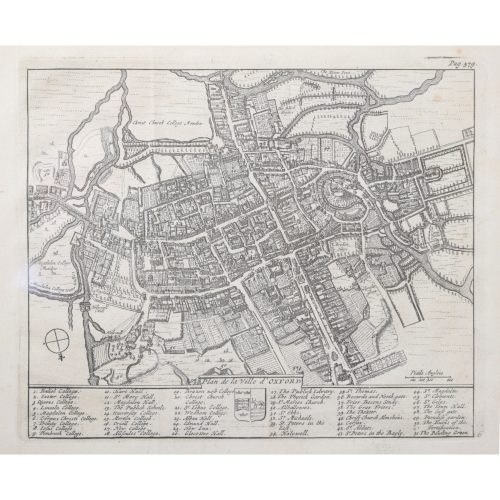
Pieter van der Aa (1659-1733), after David Loggan (1634–1692)
Map of Oxford (1727)
Engraving 12 x 16 cm An eighteenth-century map of Oxford, engraved by Pieter van der Aa after David Loggan, the noted engraver, draughtsman, and painter. The aerial view shows the city and its university buildings in all their glory. Pieter van der Aa of Leiden was a Dutch publisher best known for preparing maps and atlases, though he also printed editions of foreign bestsellers and illustrated volumes. He is noted for the many engravings he produced after David Loggan's series of Oxford and Cambridge colleges and costumes. In 1727 Van Der Aa illustrated "Les Delices de la Grande Bretagne & de L'Irelande" by James Beeverell, the book in which this engraving appears. Condition: a good impression. If you’d like to know more, please email info@manningfineart.co.uk or call us on 07929 749056. -
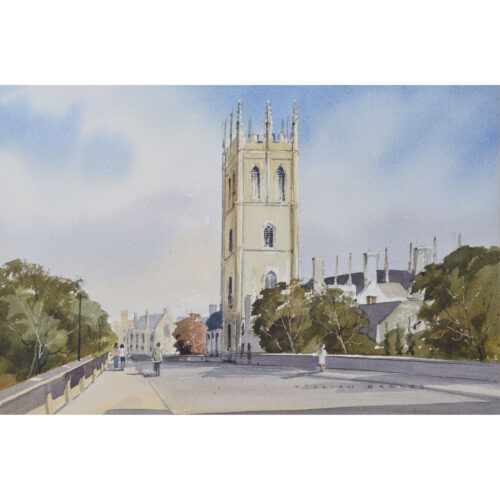
William Barnes (1916 - ?)
Magdalen Tower and Bridge
Watercolour 25 x 36 cm Signed lower right in ink. Magdalen Tower in all her glory, with pedestrians and a cyclist meandering over the bridge below. William Barnes was born in Brixton and trained at the Camberwell School of Art in the 1930s and the Wimbledon School of Art in the 1950s. Condition: good. If you are interested, please email info@manningfineart.co.uk or call us on 07929 749056. Click here for other views of Magdalen College, Oxford. -
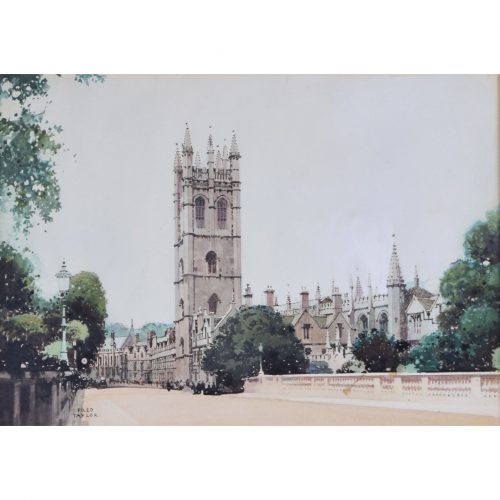
Fred Taylor (1875 - 1963)
Magdalen Tower from Magdalen Bridge
Watercolour 25 x 37 cm Signed lower left. Fred Taylor captures the indomitable features of Magdalen Tower. The spire rises into a pale sky as undergraduates stream past the entrance to the Porter's Lodge. An old-fashioned car drives up the High.This watercolour of Magdalen was a design for the front cover of a guidebook about Oxford.Fred Taylor was a London-born painter and poster designer. He studied at the Académie Julian in Paris, and Goldsmiths’ in London, later travelling to Italy on a scholarship to study art. He produced many poster designs for railway and shipping firms and was an official camoufleur during the Second World War. He exhibited at the Royal Academy.Condition: very good. If you are interested, please email info@manningfineart.co.uk or call us on 07929 749056. Click here for other views of Magdalen College, Oxford. -
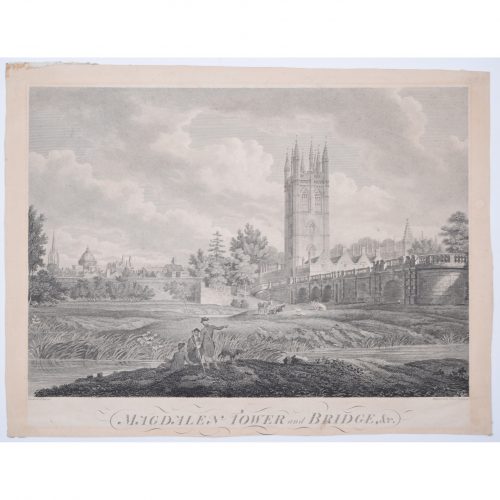
James Basire II (1769 - 1822) after Edward Dayes (1763 - 1804)
Magdalen Tower and Bridge etc. (1797)
Engraving 35 x 44 cm An engraving illustrating the pinnacles of Magdalen Tower and the Bridge below. James Basire II was a British engraver, son of James Basire I, also a celebrated engraver. In 1802 he became Engraver to the Society of Antiquaries. Edward Dayes was an English watercolour painter and mezzotint engraver. He first exhibited at the Royal Academy in 1786, when he showed a portrait and views of Waltham Cross and Canterbury. In the three following years he exhibited both miniatures and landscapes. He continued to exhibit at the Academy regularly until the year of his death, contributing a total of 64 works. He also exhibited at the Society of Artists, and worked as draughtsman to the Duke of York and Albany. Condition: generally good; some age toning within margins. If you are interested, please email info@manningfineart.co.uk or call us on 07929 749056. Click here for other views of Magdalen College, Oxford. -
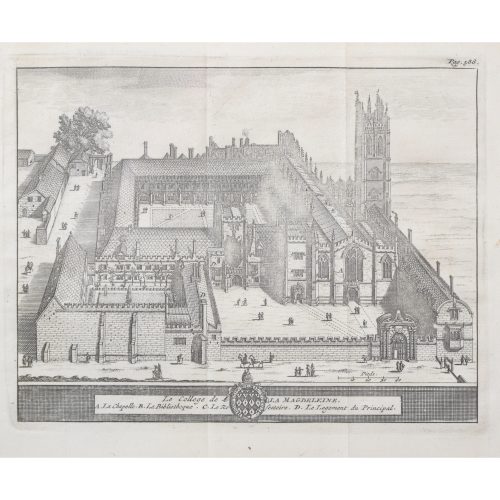
Pieter van der Aa (1659-1733), after David Loggan (1634–1692)
Magdalen College, Oxford (1727)
Engraving 12 x 16 cm A magnificent eighteenth-century view of Magdalen, engraved by Pieter van der Aa after David Loggan, the noted engraver, draughtsman, and painter. Magdalen was founded in 1458 by William of Waynflete, and is considered by many to be Oxford's most beautiful college. The college is organised around five quads; the irregularly shaped St John's Quad is the first on entering the college, and connects to the Great Quad (the Cloister) via the Perpendicular Gothic Founders Tower, which is richly decorated with carvings and pinnacles and has carved bosses in its vault. Chaplain's Quad runs along the side of the Chapel and Hall, to the foot of the Great Tower. St Swithun's Quad and Longwall Quad (which contains the Library) date from the late 19th and early 20th centuries, and make up the southwest corner of the college. Pieter van der Aa of Leiden was a Dutch publisher best known for preparing maps and atlases, though he also printed editions of foreign bestsellers and illustrated volumes. He is noted for the many engravings he produced after David Loggan's series of Oxford and Cambridge colleges and costumes. In 1727 Van Der Aa illustrated "Les Delices de la Grande Bretagne & de L'Irelande" by James Beeverell, the book in which this engraving appears. Condition: a small area slightly lacking in ink. If you’d like to know more, please email info@manningfineart.co.uk or call us on 07929 749056. -
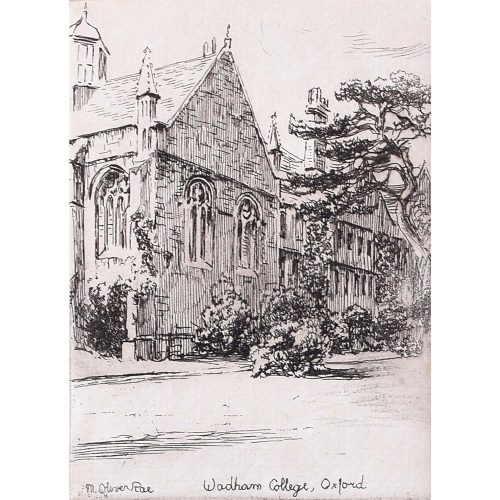
Mabel Oliver Rae (1868-1956) Wadham College Oxford
Etching Signed and titled in pencil 11x8.5 cm The rich tones of the etchings make them as popular today as when they were first made. Click here for biographical details and other pictures by the artist. If you are interested email info@manningfineart.co.uk or call us on 07929 749056. Condition: Good. -

M. Oliver Rae (1868-1956)
Wadham College, Oxford
Etching Click here for biographical details and other pictures by the artist. 11x8cm If you are interested email info@manningfineart.co.uk or call us on 07929 749056. -

M Oliver Rae
All Souls, Oxford
Engraving 22.5x15cm Click here for biographical details and other pictures by the artist. If you are interested email info@manningfineart.co.uk or call us on 07929 749056. -
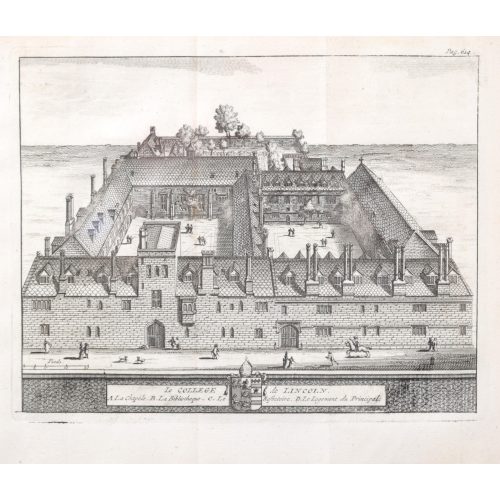
Pieter van der Aa (1659-1733), after David Loggan (1634–1692)
Lincoln College, Oxford (1727)
Engraving 12 x 16 cm An eighteenth-century view of Lincoln, engraved by Pieter van der Aa after David Loggan, the noted engraver, draughtsman, and painter. Pieter van der Aa of Leiden was a Dutch publisher best known for preparing maps and atlases, though he also printed editions of foreign bestsellers and illustrated volumes. He is noted for the many engravings he produced after David Loggan's series of Oxford and Cambridge colleges and costumes. In 1727 Van Der Aa illustrated "Les Delices de la Grande Bretagne & de L'Irelande" by James Beeverell, the book in which this engraving appears. Condition: a good impression. If you’d like to know more, please email info@manningfineart.co.uk or call us on 07929 749056. -
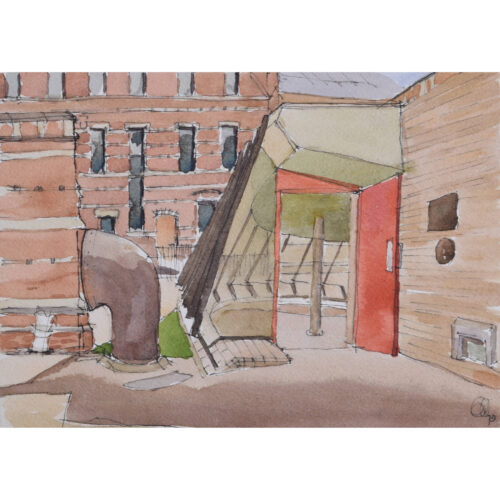
Gavin Pomeroy (born 1929)
Keble College, Oxford
Watercolour 17 x 25 cm Signed and dated lower right. A watercolour of Keble College. Pomeroy juxtaposes the red brick of the original 1870s buildings with the glass and metal of one of the modernist additions to the college in the 1970s: the ABK buildings, including the glass "goldfish bowl" bar. William Gavin Ingram Pomeroy was born in Newlyn, Cornwall. From 1947 he studied architecture under Geoffrey Bazeley, and later became a lecturer for the Plymouth School of Architecture. He became the senior lecturer in architecture at what is now Plymouth University and retired in 1999. Condition: generally very good. If you’d like to know more, please email info@manningfineart.co.uk or call us on 07929 749056. Click here for more views of Keble College. -
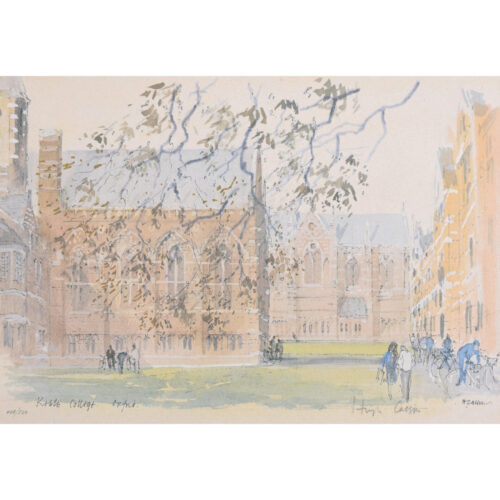
Hugh Casson (1910 - 1999)
Keble College, Oxford
Lithograph 25 x 36 cm Signed and numbered 408/500, both in pencil. Casson's autumnal depiction of Keble, complete with students and ubiquitous bicycles. Sir Hugh Casson was educated at Eastbourne College; St John’s College, Cambridge; and the Bartlett School of Architecture. Trained in the 1930s in the early modernist style, he taught at the Cambridge School of Architecture. After employment as a camoufleur during World War 2 by the Air Ministry, in 1948 he was appointed as director of architecture for the Festival of Britain. A close friend of the Royal Family, he undertook designs for the 1953 coronation, designed the interior of the Royal Yacht Britannia (“The overall idea was to give the impression of a country house at sea”), and taught the young Charles III to paint in watercolours. Amongst his architectural achievements are the Elephant House at London Zoo, the 1978 redevelopment of Bristol Docks, the Raised Faculty Building for The University of Cambridge, and a building for the Royal College of Art. He published a number of illustrated books, of which Casson’s Oxford and Casson’s Cambridge are probably the best known. A limited edition series of prints was produced from the paintings. Condition: generally very good. If you’d like to know more, please email info@manningfineart.co.uk or call us on 07929 749056. Click here for other views of Keble College, Oxford. -
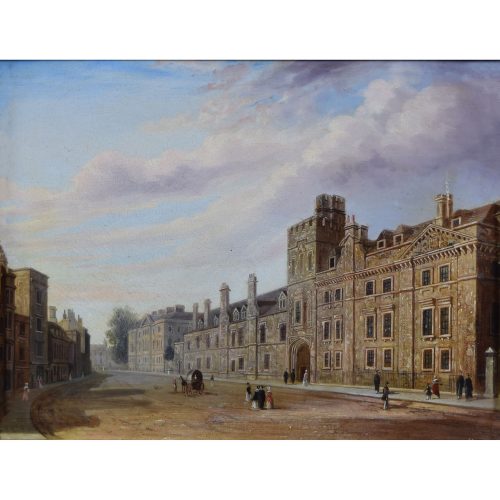
Joseph Murray Ince (1806-1859) (attributed)
Balliol College, Oxford
Oil on board 22.5x29cm (9 x 11.5 in.) In a fine hand-finished black and gilt frame. If you are interested email info@manningfineart.co.uk or call us on 07929 749056. Brought up in Radnorshire, in Wales, Ince studied under David Cox from 1823-1826, and then exhibited at the Royal Academy. He was a drawing master at Cambridge University during the 1830s, during which period he painted many views of the Colleges of both Oxford and Cambridge, returning to Radnorshire in 1835. His works are in the collections of major galleries including the Tate, The V&A and The Fitzwilliam Museum in Cambridge. -
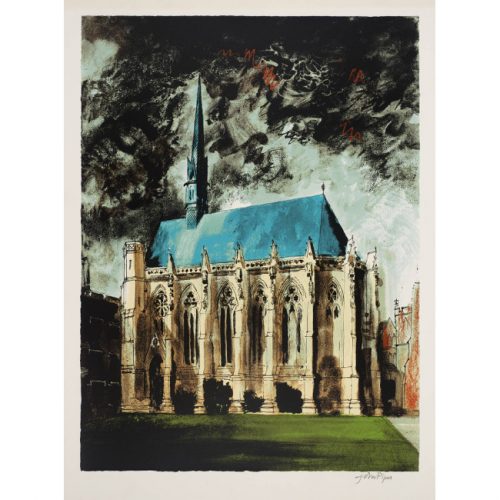
John Piper (1903–1992)
Exeter College, Oxford (1977)
Screenprint Signed in pencil 81.9x61cm (32.2x24 inches) One of Piper's largest and most impressive prints, here featuring Gilbert Scott's chapel at Exeter. It is often claimed that Gilbert Scott based it on Paris's Sainte Chapelle. If you are interested email info@manningfineart.co.uk or call us on 07929 749056. Condition: slight even age toning to paper, small area of repair to print. -
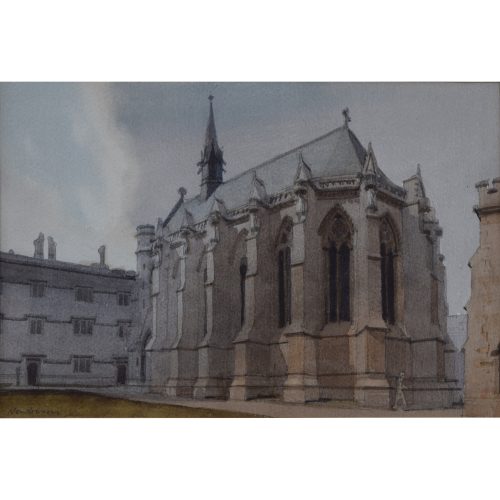
John Newberry RWS (b. 1934)
Exeter College Chapel, Oxford (1979)
Watercolour 18x27cm Newberry read Architecture at Cambridge and then Fine Art at Newcastle. For many years he taught at the Ruskin School of Drawing in Oxford. If you are interested email info@manningfineart.co.uk or call us on 07929 749056. -
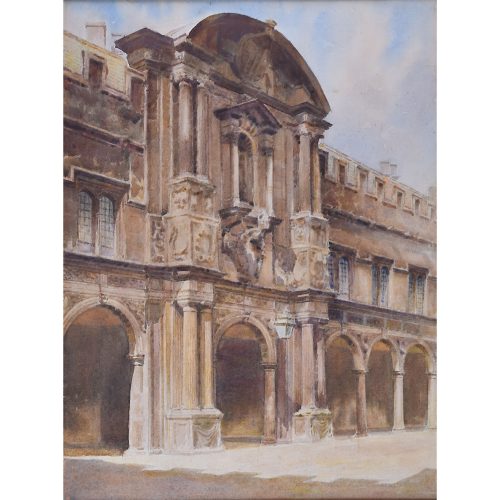
John Fulleylove (1845-1908) attributed Canterbury Quad, St John's College Oxford
Watercolour over pencil, unsigned 40.5x30.5cm Born in Leicester, John Fulleylove trained as an architect with a Leicester firm before becoming a full-time painter. He exhibited widely in the UK, at such venues as the Royal Academy, the Fine Art Society, and the Royal Society of British Artists. His paintings were the subject of illustrated topographical books, including one on ‘Oxford’ published by the Fine Art Society. If you are interested email info@manningfineart.co.uk or call us on 07929 749056. Condition: Laid to thick card support; generally very good, two small spots to sky visible in photograph. -
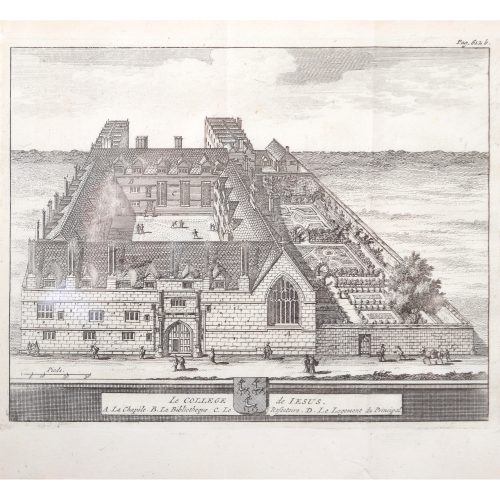
Pieter van der Aa (1659-1733), after David Loggan (1634–1692)
Jesus College, Oxford (1727)
Engraving 12 x 16 cm An eighteenth-century view of Jesus College, engraved by Pieter van der Aa after David Loggan, the noted engraver, draughtsman, and painter. Pieter van der Aa of Leiden was a Dutch publisher best known for preparing maps and atlases, though he also printed editions of foreign bestsellers and illustrated volumes. He is noted for the many engravings he produced after David Loggan's series of Oxford and Cambridge colleges and costumes. In 1727 Van Der Aa illustrated "Les Delices de la Grande Bretagne & de L'Irelande" by James Beeverell, the book in which this engraving appears. Condition: a good impression. If you’d like to know more, please email info@manningfineart.co.uk or call us on 07929 749056. -
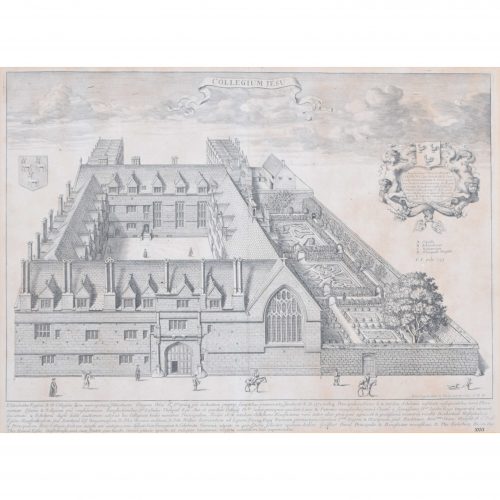
David Loggan (1634 - 1692)
Jesus College, Oxford (1705)
Engraving 29 x 41 cm Loggan was born to English and Scottish parents, and was baptised in Danzig in 1634. After studying engraving in Danzig with Willem Hondius (1598 - 1652 or 1658), he moved to London in the late 1650s, going on to produce the engraved title-page for the folio 1662 Book of Common Prayer. He married in 1663 and moved to Nuffield in Oxfordshire in 1665. Loggan was appointed Public Sculptor to the nearby University of Oxford in the late 1660s, having been commissioned to produce bird’s-eye views of all the Oxford colleges. He lived in Holywell Street as he did this. The 'Oxonia Illustrata' was published in 1675, with the help of Robert White (1645 - 1704). Following its completion, Loggan began work on his equivalent work for Cambridge; the 'Cantabrigia Illustrata' was finally published in 1690, when he was made engraver to Cambridge University. The "Oxonia Illustrata" also includes an engraving of Winchester College (Winchester and New College share William of Wykeham as their founder) whilst the "Cantabrigia Illustrata" includes one of Eton College (which shares its founder, Henry VIII, with King’s College). Bird’s-eye views from this era required a particular talent as an architectural perspectivist; it was not until 1783 that it became possible for artists to ascend via hot air balloons and view the scenes they were depicting from above. Loggan thus had to rely on his imagination in conceiving the views. Loggan’s views constitute the first accurate depictions of the two Universities, in many ways unchanged today. Whilst the Oxford engravings were produced in reasonable numbers and ran to a second edition by Henry Overton (on thicker paper and with a plate number in Roman numerals in the bottom right-hand corner), those of Cambridge were printed in much smaller numbers. The Dutchman Pieter van der Aa published some miniature versions of the engravings for James Beverell’s guidebook to the UK, ''Les Delices de la Grande Bretagne'' (circa 1708). The contemporary artist Andrew Ingamells has produced a highly-acclaimed series of etchings which bring Loggan’s original vision up to date. Condition: generally very good. Slight time staining. If you’d like to know more, please email info@manningfineart.co.uk or call us on 07929 749056. -
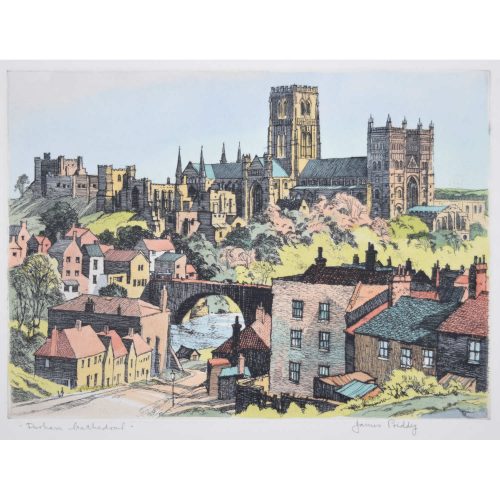
James Priddey (1916-1980) FRSA RBSA
Durham Cathedral Lithograph
27 x 36cm A Birmingham-based artist, educated at the Birmingham College of Art and a member of the Royal Birmingham Society of Artists, Priddey has a very distinctive style which he applies to his topographical watercolours. This striking view of Durham illustrates the city's river and cathedral. Condition: mounted to board. If you’d like to know more, please email info@manningfineart.co.uk or call us on 07929 749056. -
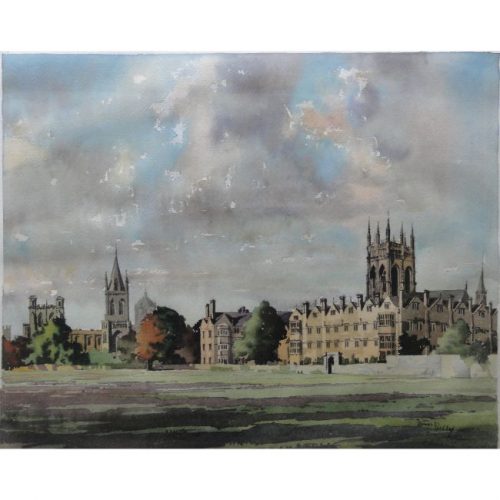
James Priddey (1916-1980) FRSA RBSA
Merton College, Oxford
Watercolour and ink 35 x 42cm (13.7×16.5 in.) If you are interested email info@manningfineart.co.uk or call us on 07929 749056. A Birmingham-based artist, educated at the Birmingham College of Art and member of the Royal Birmingham Society of Artists. Priddey had a very distinctive style which he applied to his topographical watercolours. -
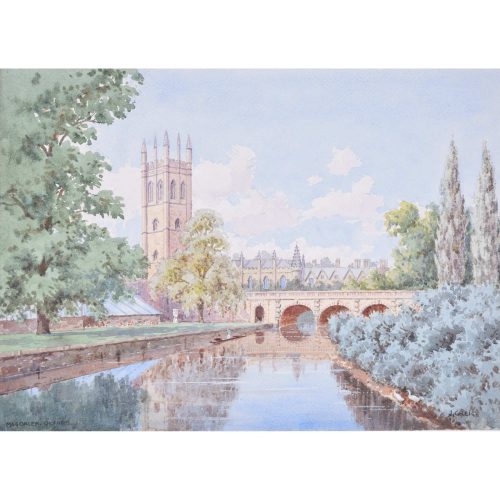
James Greig (1861-1941)
Magdalen College, Oxford
Watercolour 28 x 38.5cm (11 x 15 in.) Greig was born in Arbroath, moving in 1891 to London to study art and furthering his education in Paris between 1895 and 1896. Returning to London he produced magazine illustrations for publications such as Punch and The Sketch in black and white. He was art critic for the Morning Post, showing his skills at writing as an historian, also editing the diaries of the landscape painter Joseph Farington (1747-1821) and publishing articles on Gainsborough and Raeburn. Elected Member of the Royal Society of British Artists in 1898 he was renowned for his colourful landscapes of the middle east and his views of Oxford. He also designed posters for Union Castle Line and P&O. If you are interested email info@manningfineart.co.uk or call us on 07929 749056. -
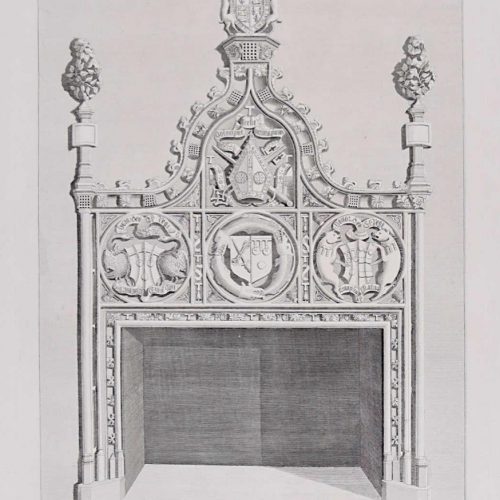
James Basire
James Basire engraving of Bishop's Palace Exeter
Engraving 50 x 33 cm (to plate mark) Published by the Society of Antiquaries 23rd April 1796. A member of the Society of Antiquaries, Basire specialised in architectural prints. He was appointed as engraver to the society, much of his finest works being found in their Vestuta Monumenta. Basire's father Isaac was a cartographer, and both his son and grandson were called James and also worked for the society. William Blake was apprenticed to Basire for seven years. If you are interested, email info@manningfineart.co.ukor call us on 07929 749056. -
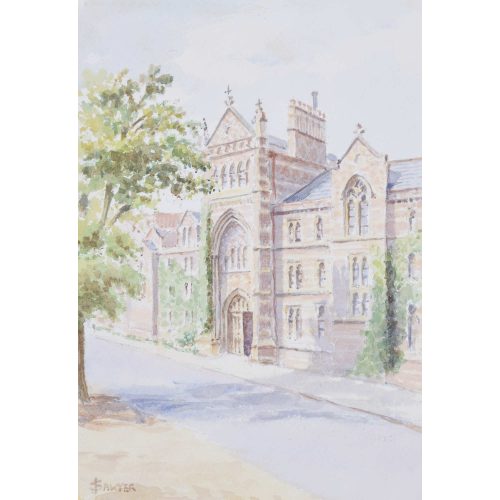
J Sawyer (British, 20th Century) Keble College, Oxford
watercolour 25x17cm If you are interested email info@manningfineart.co.uk or call us on 07929 749056. -
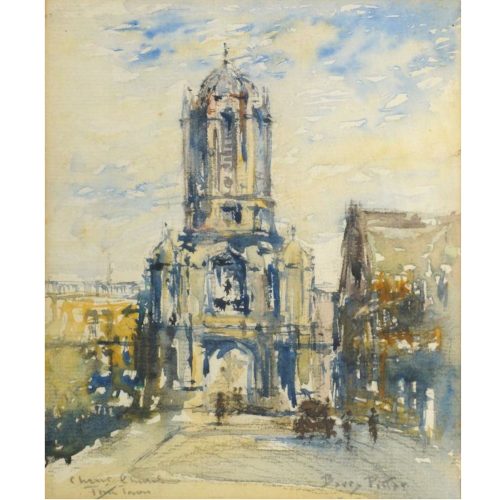
J F Barry Pittar (British 1880-1948) Tom Tower, Christ Church Oxford
Watercolour 15.5x13cm If you are interested email info@manningfineart.co.uk or call us on 07929 749056. Condition: Good. -
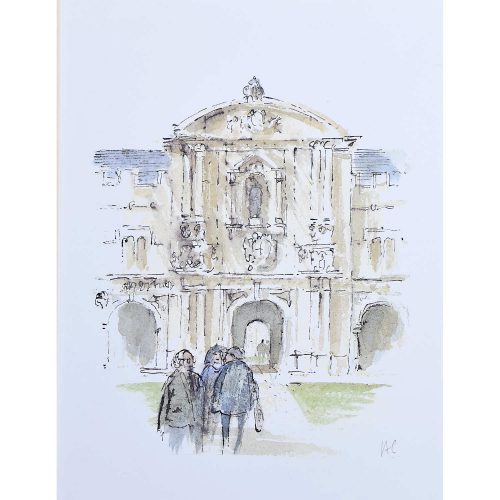
Hugh Casson (1910 - 1999)
St John's College, Oxford
Initalled in pencil 25 x 20 cm From Casson’s ever-popular Oxford and Cambridge series of prints. Sir Hugh Casson was educated at Eastbourne College; St John’s College, Cambridge; and the Bartlett School of Architecture. Trained in the 1930s in the early modernist style, he taught at the Cambridge School of Architecture. After employment as a camoufleur during World War 2 by the Air Ministry, in 1948 he was appointed as director of architecture for the Festival of Britain. A close friend of the Royal Family, he undertook designs for the 1953 coronation, designed the interior of the Royal Yacht Britannia (“The overall idea was to give the impression of a country house at sea”), and taught the Prince of Wales to paint in watercolours. Amongst his architectural achievements are the Elephant House at London Zoo, the 1978 redevelopment of Bristol Docks, the Raised Faculty Building for The University of Cambridge, and a building for the Royal College of Art. He published a number of illustrated books, of which Casson’s Oxford and Casson’s Cambridge are probably the best known. A limited edition series of prints was produced from the paintings. Condition: excellent. If you’d like to know more, please email info@manningfineart.co.uk or call us on 07929 749056. -
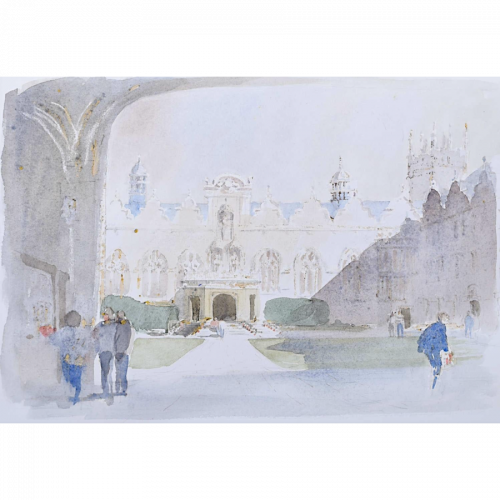
Hugh Casson (1910 - 1999)
Oriel College, Oxford
27 x 39 cm Watercolour We are lucky to be able to offer here the original watercolour from which Casson’s print of the College was produced. We also (elsewhere on the site) offer the print from his ever-popular Oxford and Cambridge series. Sir Hugh Casson was educated at Eastbourne College; St John’s College, Cambridge; and the Bartlett School of Architecture. Trained in the 1930s in the early modernist style, he taught at the Cambridge School of Architecture. After employment as a camoufleur during World War 2 by the Air Ministry, in 1948 he was appointed as director of architecture for the Festival of Britain. A close friend of the Royal Family, he undertook designs for the 1953 coronation, designed the interior of the Royal Yacht Britannia (“The overall idea was to give the impression of a country house at sea”), and taught the Prince of Wales to paint in watercolours. Amongst his architectural achievements are the Elephant House at London Zoo, the 1978 redevelopment of Bristol Docks, the Raised Faculty Building for The University of Cambridge, and a building for the Royal College of Art. He published a number of illustrated books, of which Casson’s Oxford and Casson’s Cambridge are probably the best known. A limited edition series of prints was produced from the paintings. Condition: excellent. If you’d like to know more, please email info@manningfineart.co.uk or call us on 07929 749056. -
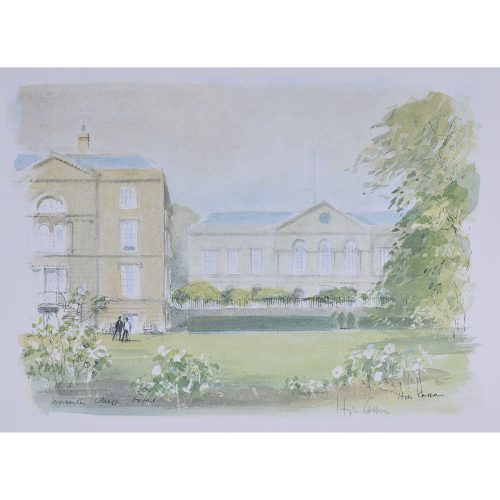
Sir Hugh Casson (1910-1999)
Worcester College Oxford
Signed in pencil, lithographic proof print aside from the limited edition of 500. Provenance: the artist’s estate. 28 x 35 cm (11 x 14 in) From Casson’s ever-popular Oxford series of prints. If you are interested email info@manningfineart.co.uk or call us on 07929 749056. For biographical details and other works by the artist click here. -
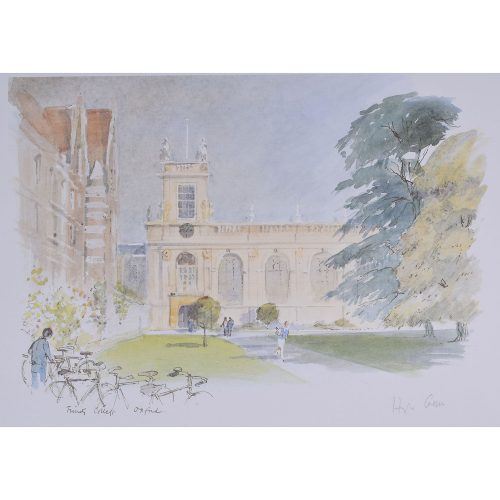
Hugh Casson
Trinity College, Oxford
Lithographic proof print signed in pencil, aside from the limited edition of 500. Provenance: the artist’s estate. 28 x 35 cm (11 x 14 in) From Casson’s ever-popular Oxford series of prints. If you are interested email info@manningfineart.co.uk or call us on 07929 749056. For biographical details and other works by the artist click here. -
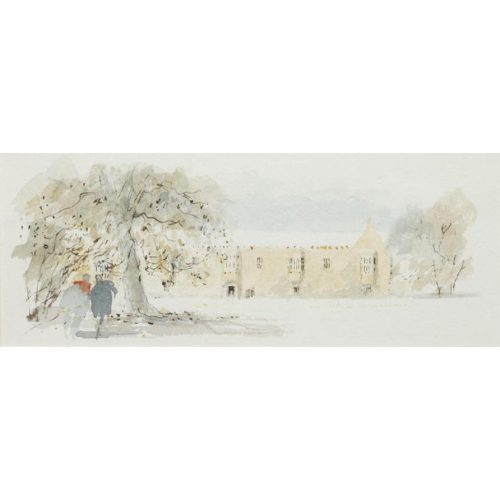 Sir Hugh Casson CH, KCVO, PRA, RDI (1910-1999) St John’s College, Oxford, Canterbury Quad Signed, inscribed with title and dated ‘1988’ (on a label attached to the backboard) Pencil, pen, ink and watercolour 10.5 x 27cm (4 1/8 x 10 5/8in). Painted for inclusion in Hugh Casson’s Oxford (Phaidon Press Ltd, 1988). Click here for biographical details and other works by the artist. If you are interested email info@manningfineart.co.uk or call us on 07929 749056.
Sir Hugh Casson CH, KCVO, PRA, RDI (1910-1999) St John’s College, Oxford, Canterbury Quad Signed, inscribed with title and dated ‘1988’ (on a label attached to the backboard) Pencil, pen, ink and watercolour 10.5 x 27cm (4 1/8 x 10 5/8in). Painted for inclusion in Hugh Casson’s Oxford (Phaidon Press Ltd, 1988). Click here for biographical details and other works by the artist. If you are interested email info@manningfineart.co.uk or call us on 07929 749056. -
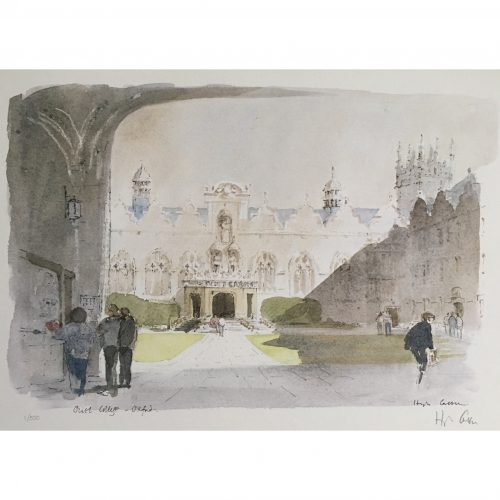
Sir Hugh Casson (1910-1999)
Oriel College Oxford
Lithographic print signed in pencil and numbered 1/500. Provenance: the artist's estate. 28 x 35 cm (11 x 14 in) From Casson's ever-popular Oxford series of prints. If you are interested email info@manningfineart.co.uk or call us on 07929 749056. Click here to see other posters from this series and for more information on Wings for Victory campaigns. -

Sir Hugh Casson (1910-1999)
Oriel College Oxford
Lithographic print signed in pencil, artist's proof print aside from the numbered series of 500. Provenance: the artist's estate. 28 x 35 cm (11 x 14 in) From Casson's ever-popular Oxford series of prints. If you are interested email info@manningfineart.co.uk or call us on 07929 749056. For biographical details and other works by the artist click here. -

Sir Hugh Casson (1910-1999)
Magdalen Bridge Oxford
Lithographic print unsigned. Provenance: the artist’s estate. 28 x 35 cm (11 x 14 in) From Casson’s ever-popular Oxford series of prints. If you are interested email info@manningfineart.co.uk or call us on 07929 749056. For biographical details and other works by the artist click here. -
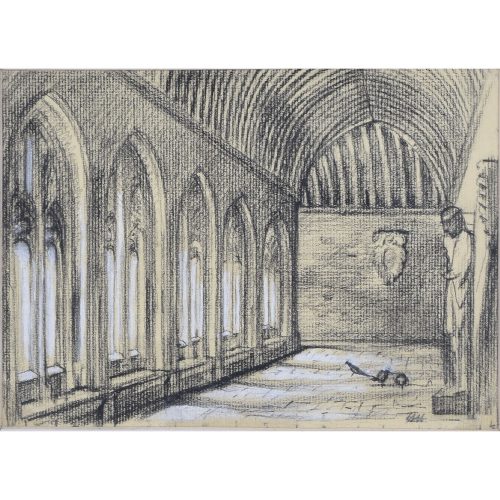
Hubert Hennes (b. 1907)
New College, Oxford (sketch)
Crayon and watercolour Signed 14x21cm If you are interested email info@manningfineart.co.uk or call us on 07929 749056. -
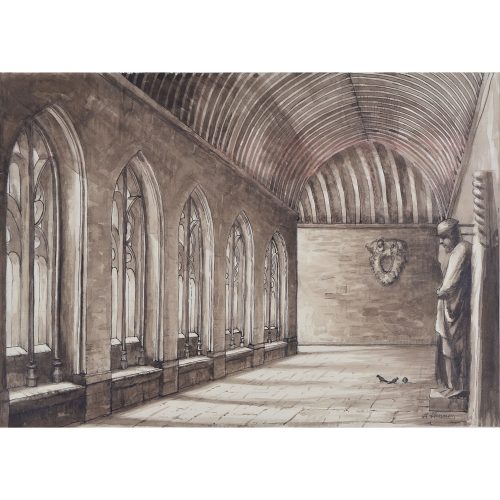
Hubert Hennes (b.1907)
New College, Oxford
Watercolour 30x42cm If you are interested email info@manningfineart.co.uk or call us on 07929 749056. -
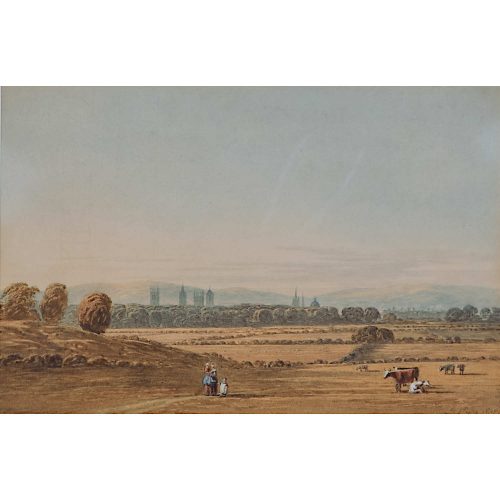
George Pyne (1800-1884) Panoramic View of Oxford (1849)
Watercolour 18.5x28cm Pyne was the elder son of William Henry Pyne, the publisher artist behind the monumental History of the Royal Residences, and son-in-law of John Varley – two founders of the Society of Painters in Watercolours. Living in Oxford from the 1850s until his death, he brought the hand of an architectural draughtsman to his views of Oxford, the works for which he is best known, but with an artist’s ability to represent the romance of old stone. His views of Cambridge and Eton also contribute to his valuable and historical record of the period. If you are interested email info@manningfineart.co.uk or call us on 07929 749056. Condition: Very good. Signed l/right 'G Pyne 1849'. -
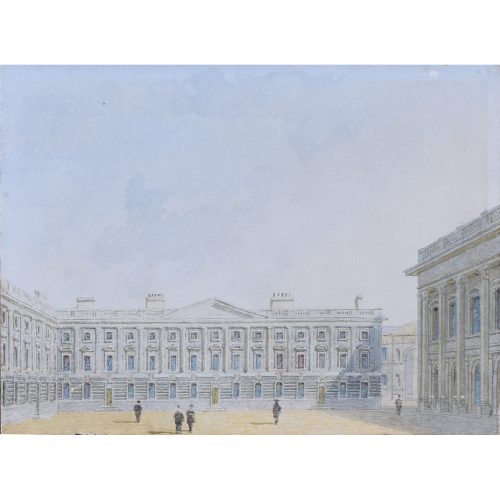
George Pyne
Peckwater Quad, Christ Church, Oxford
Watercolour 13x18cm Click here for biographical details and other works by the artist. If you are interested email info@manningfineart.co.uk or call us on 07929 749056. -
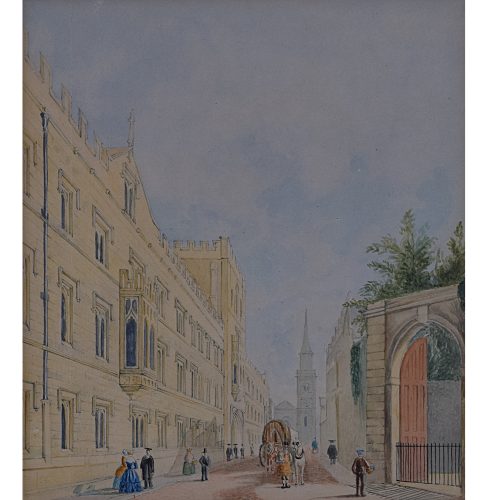
George Pyne (1800-1884) Exeter College, Oxford
Watercolour 22x18.5cm Pyne was the elder son of William Henry Pyne, the publisher artist behind the monumental History of the Royal Residences, and son-in-law of John Varley – two founders of the Society of Painters in Watercolours. Living in Oxford from the 1850s until his death, he brought the hand of an architectural draughtsman to his views of Oxford, the works for which he is best known, but with an artist’s ability to represent the romance of old stone. His views of Cambridge and Eton also contribute to his valuable and historical record of the period. If you are interested email info@manningfineart.co.uk or call us on 07929 749056. Condition: Generally excellent condition. -
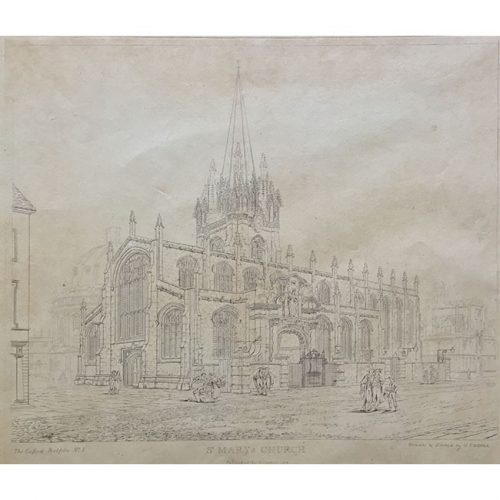
G. Cooper
St. Mary's Church, Oxford
Etching c. 1820 40x47cm From The Oxford Portfolio a series of thirteen views printed on Sepia paper, very rare. If you are interested email info@manningfineart.co.uk or call us on 07929 749056. -
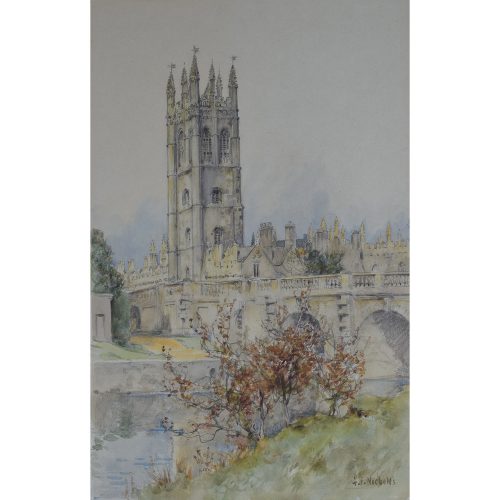
George Frederick Nicholls (1850-1935)
Magdalen College from the Cherwell, Oxford
Watercolour 37x24cm Early twentieth century. Born in Great Saughall in Cheshire - and dying in Chester - he subsequently lived in Worcestershire and Oxfordshire. Many of his paintings are of the Cotswolds and Oxford, and he is best known for his topographical paintings. He painted the illustrations for a series of county books for A & C Black, including Cornwall (1915) and Cotswolds (1920). If you are interested email info@manningfineart.co.uk or call us on 07929 749056. -
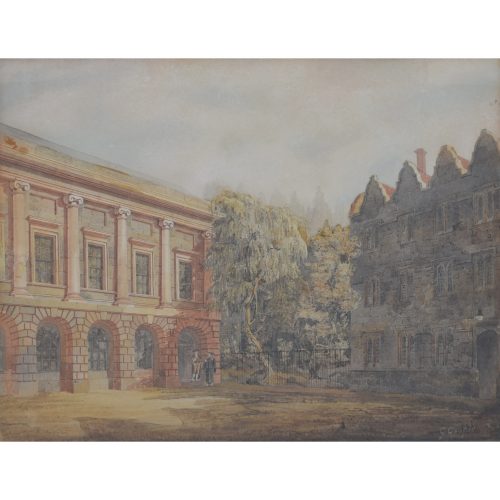
G. Cooper
Oriel College, Oxford
Watercolour 27 x 35 cm A view of Oriel's Second Quad, featuring the Wyatt Building on the left. Designed in the Neoclassical style by James Wyatt, it was built between 1788 and 1796 when the College's library doubled in size thanks to a generous gift by Edward, Baron Leigh, formerly High Steward of the university and an alumnus of Oriel. The building has rusticated arches on the ground floor and a row of Ionic columns above, dividing the façade into seven bays. Cooper's watercolour focuses on the architectural merit of the building, highlighting the sandy tone of Oxford's famous Headington stone. Two figures in academic dress take part in a spirited discussion just outside the building. Condition: generally very good. -
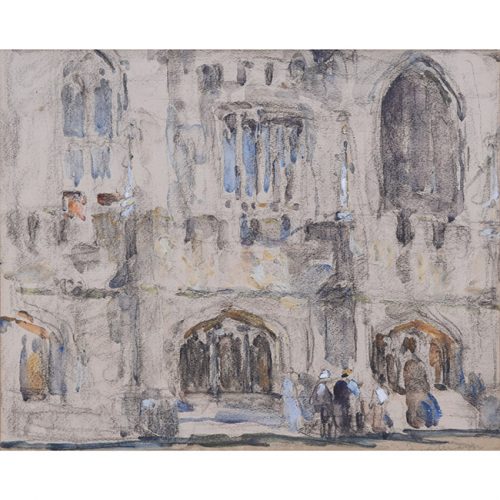
Fred Mayor (British, 1865-1916)
Magdalen College, Oxford
Watercolour and pencil 12x15" In this painting, Mayor catches Magdalen in his usual impressionistic style, with an effective use of splashes of colour and careful use of lighting. Born near Ripon in Yorkshire, Mayor was educated at St Edmund's School Canterbury where he excelled both at drawing and cricket. The former became his profession and he began with a studio in Chiswick shared with Frank Brangwyn. In 1886 he followed the well-trodden path of spending time in Paris, studying at the Academie Julian, and also meeting Wilson Steer and Walter Sickert who influenced his work and were lifelong friends of his. In 1888 at the age of just twenty-one a painting of his was accepted at the Royal Academy of Arts. In 1899 he moved to join the artists' colony in Staithes, Yorkshire, where other artists included Harold and Dame Laura Knight. He met, and subsequently married, another artist - Sheffield-born Hannah Hoyland. Married life began by eloping to Montreuil-sur-Mer in northern France where Mayor developed his characteristic impressionistic style. He died in 1916 whilst undergoing a routine operation for asthma, which was required before he could become a war artist. -
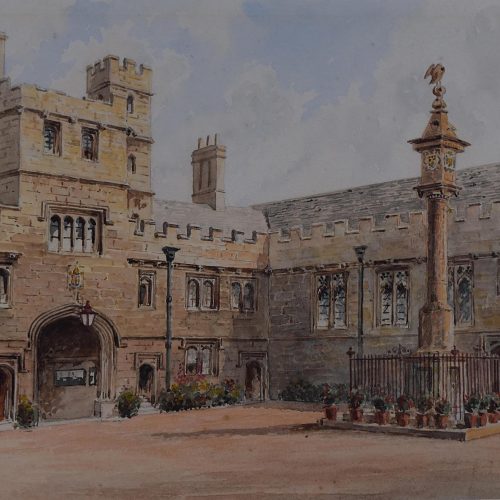
Francis Philip Barraud RA (1834-1901)
Corpus Christi College, Oxford
Watercolour 23 x 33cm Signed lower right. Barraud came from a family of painters. William and Henry were brothers, born in 1810 and 1811 respectively, the former a painter of equine subjects and hounds, the latter a landscape painter, and unusually the two of them made a habit of painting joint commissions. Francis, born in 1824, was a noted topographical artist, being well known for his views of Oxford in particular. Here he handles the old stonework of the College very capably, impressionistic flowers enhancing the scene. If you are interested email info@manningfineart.co.uk or call us on 07929 749056. -

after Michael Angelo Rooker (1743/6 - 1801)
North West view of Friar Bacon's Study, and Folly Bridge
Engraving 30 x 45 cm Friar Bacon's Study was built as a watchtower in the thirteenth century. The name is 'merely traditional, and not in any Record to be found', according to the 1773 text 'The Antient and Present State of the City of Oxford'; it is said to have been used by the Franciscan Friar Roger Bacon as an astronomical observatory. For hundreds of years after Friar Bacon's use of it, the tower was a notable landmark in Oxford, and Samuel Pepys visited it in 1668: 'So to Friar Bacon's study: I up and saw it, and gave the man a shilling. Oxford mighty fine place.' The Study was often considered a folly, and the bridge is now known as Folly Bridge. Rooker painted the tower in 1780 - around the same time as the tower was demolished - and James Basire produced an engraving of his painting in 1787, to be used as the frontispiece for the Oxford Almanack. The Oxford Almanack was an annual almanack published by the Oxford University Press for the University of Oxford from 1674 through 2019 (when printing sadly ceased due to "dwindling interest"). The almanack traditionally included engravings or lithographs of the University and information about the upcoming year. Other almanack artists have included Michael Burghers, J. M. W. Turner, and John Piper. Basire and Dayes collaborated on several views of Oxford during the courses of their careers. Michael Angelo Rooker ARA was an English oil and watercolour painter of architecture and landscapes, illustrator, and engraver. Rooker's original painting currently hangs in Worcester College. Condition: good; in handsome (worn) antique Hogarth frame. If you are interested, please email info@manningfineart.co.uk or call us on 07929 749056. Click here for other non-collegiate views of Oxford. -
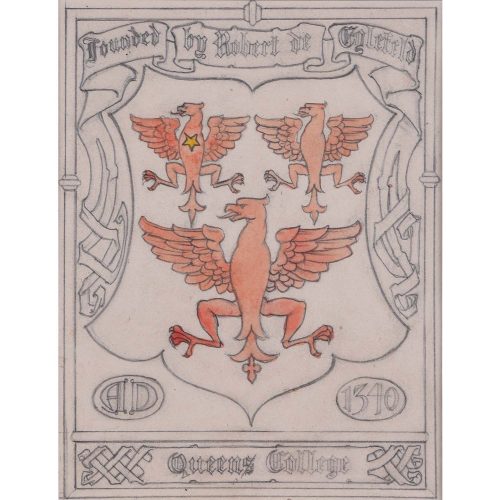
Florence Camm (1874-1960) Design for Stained Glass Window For Queen's College Oxford
Watercolour 15x11 cm Design for TW Camm & Co., Smethwick, Birmingham For biographical details and other works by the artist click here. If you are interested email info@manningfineart.co.uk or call us on 07929 749056. Conditon: Good. In conservation mount and in plastic sleeve for protection. -
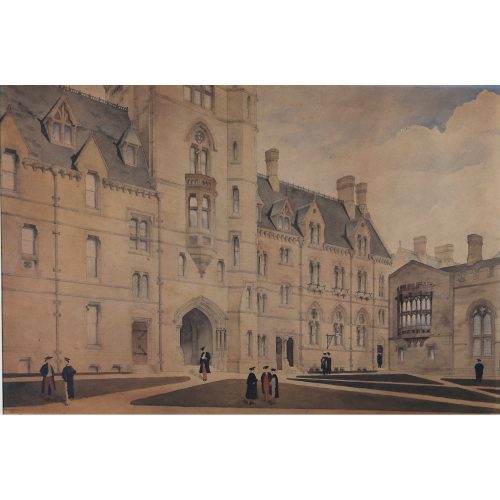 F F Hoyland Balliol College, Oxford (1880) Watercolour 44 x 66 cm Signed lower left and dated. An impressive watercolour of Balliol College. Scholars, sporting gowns and mortarboards, gather in the quad. Hoyland's stylistic precision transforms this watercolour into a beautifully executed depiction of the College's architecture.
F F Hoyland Balliol College, Oxford (1880) Watercolour 44 x 66 cm Signed lower left and dated. An impressive watercolour of Balliol College. Scholars, sporting gowns and mortarboards, gather in the quad. Hoyland's stylistic precision transforms this watercolour into a beautifully executed depiction of the College's architecture. -
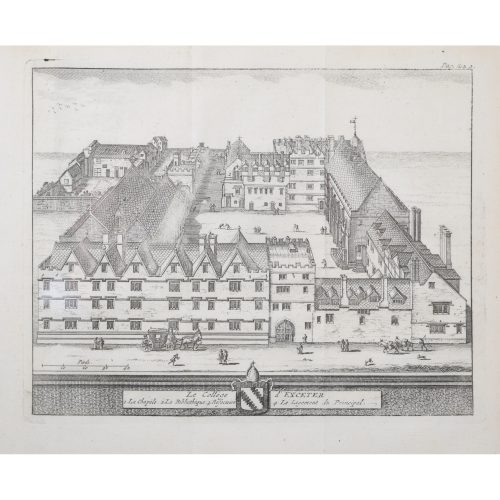
Pieter van der Aa (1659-1733), after David Loggan (1634–1692)
Exeter College, Oxford (1727)
Engraving 12 x 16 cm An eighteenth-century view of Exeter, engraved by Pieter van der Aa after David Loggan, the noted engraver, draughtsman, and painter. Pieter van der Aa of Leiden was a Dutch publisher best known for preparing maps and atlases, though he also printed editions of foreign bestsellers and illustrated volumes. He is noted for the many engravings he produced after David Loggan's series of Oxford and Cambridge colleges and costumes. In 1727 Van Der Aa illustrated "Les Delices de la Grande Bretagne & de L'Irelande" by James Beeverell, the book in which this engraving appears. Condition: a good impression. If you’d like to know more, please email info@manningfineart.co.uk or call us on 07929 749056. -
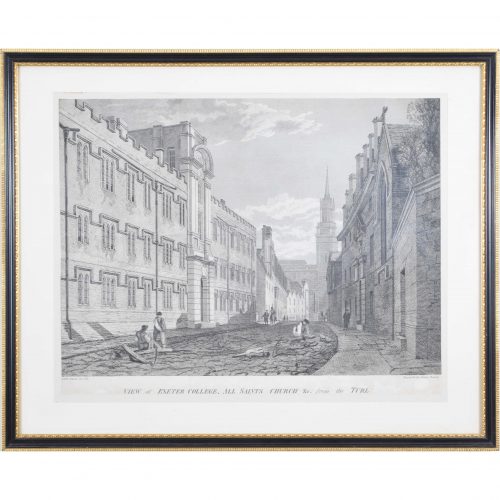
James Basire II (1769 - 1822) after JMW Turner (1775 - 1851)
View of Exeter College, All Saints Church &c. from the Turl
Engraving 35 x 46 cm A view of Exeter College, Oxford from Turl Street. Labourers cobble the road. The spire of what was All Saints Church, now Lincoln College's library, overlooks the scene. Turner's drawing was reproduced as a lithograph in 1800, to be published in the “Oxford Almanack”. The Oxford Almanack was an annual almanack published by the Oxford University Press for the University of Oxford from 1674 through 2019 (when printing sadly ceased due to “dwindling interest”). The almanack traditionally included engravings or lithographs of the University and information about the upcoming year. Other almanack artists have included Michael Burghers and John Piper. Basire and Dayes collaborated on several views of Oxford during the courses of their careers. Joseph Mallord William Turner RA, known in his time as William Turner, was an English Romantic painter, printmaker and watercolourist. He is known for his expressive colouring, imaginative landscapes and turbulent, often violent, marine paintings. He left behind more than 550 oil paintings, 2,000 watercolours, and 30,000 works on paper. He was championed by the leading English art critic John Ruskin from 1840, and is today regarded as having elevated landscape painting to an eminence rivalling history painting. James Basire II was a British engraver, son of James Basire I, also a celebrated engraver. In 1802 he became Engraver to the Society of Antiquaries. Condition: trimmed within plate mark and mounted to paper. If you’d like to know more, please email info@manningfineart.co.uk or call us on 07929 749056. Other views of Exeter College, Oxford are available here. -
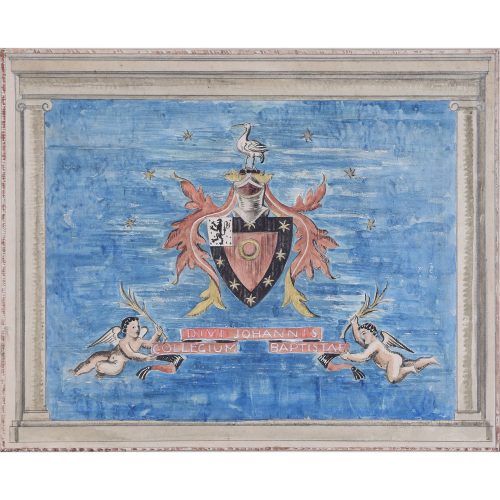
Sir Edward Brantwood Maufe KBE RA FRIBA (1882-1974)
Heraldic Design for a carpet for the Senior Common Room, St John’s College Oxford
Watercolour and ink Signed and inscribed Provenance: The estate of Bernard Bumpus If you are interested email info@manningfineart.co.uk or call us on 07929 749056. 37x46cm (14.5×18.1 inches) Maufe designed buildings for his old Oxford College, St John’s, over an extended period, starting with two memorial slabs in 1923, and was made honorary fellow in 1943. His most major works were the Rawlinson Building extension (1933) and Dolphin Quad (1947). This design relates to the 1936 remodelling of the smoking room of the Senior Common Room. Click here for biographical details and other works by the artist. -
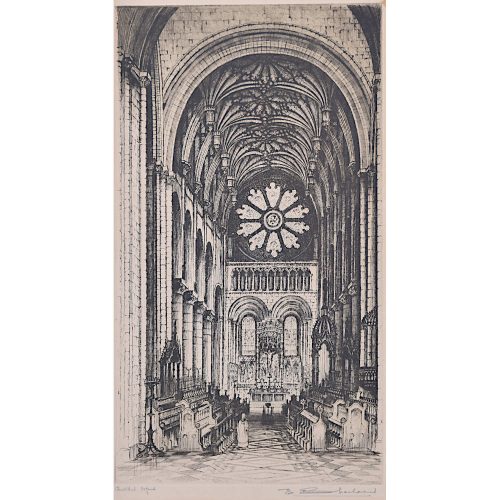
Edward W Sharland (1884-1967) - British Christ Church Cathedral Oxford interior
Etching 32x18cm Sharland was a Bristol-based artist who specialised in architectural views such as this, the interiors of cathedrals being a particular speciality. The British Museum holds copies of his cathedral interior etchings. -
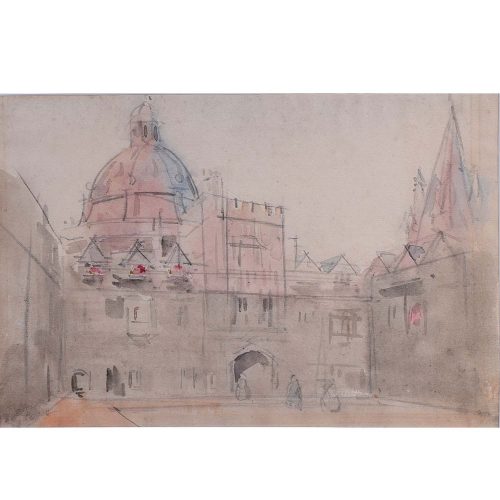
Dugald Sutherland MacColl Brasenose College, Oxford
Pencil and Wash 24x31cm 44x51cm including frame, UK shipping only MacColl was Keeper of the Tate 1906-1911, and from 1911-1924 of the Wallace Collection. A more worked-up version of this painting appears in the Tate collection and may be seen on their website. If you are interested email info@manningfineart.co.uk or call us on 07929 749056. Condition: Good. Paper lightly ripped, slight discolouration and some light staining to margins. -
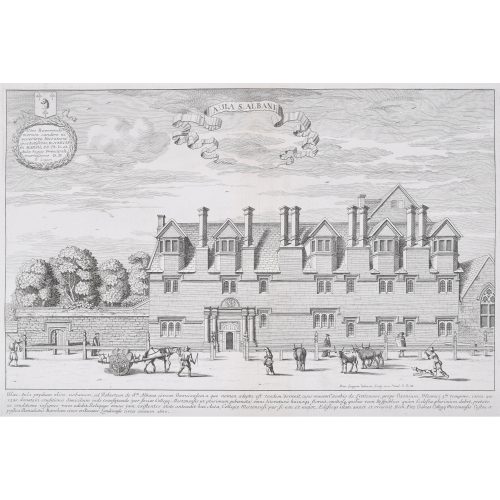
David Loggan (1634-1692) St Alban Hall, Merton College, Oxford
Aula St Albani Engraving (1675) 25x35cm St Alban's Quad was originally St Alban Hall, a medieval student residence that survived as an independent Hall of the University until 1882, when it was incorporated with Merton College. John Henry Newman briefly held the position of vice-principal in 1825. The St Alban's Hall buildings were reconstructed by Basil Champneys in 1905-1910. If you are interested, please email info@manningfineart.co.uk or call us on 07929 749056. -

David Loggan (1634-1692)
Queen's College, Oxford (1674)
Engraving, 30 x 41cm Loggan was born to English and Scottish parents, and was baptised in Danzig in 1634. After studying engraving in Danzig with Willem Hondius (1598-1652 or 1658), he moved to London in the late 1650s, going on to produce the engraved title-page for the folio 1662 Book of Common Prayer. He married in 1663 and moved to Nuffield in Oxfordshire in 1665. Loggan was appointed Public Sculptor to the nearby University of Oxford in the late 1660s, having been commissioned to produce bird’s-eye views of all the Oxford colleges. He lived in Holywell Street as he did this. The 'Oxonia Illustrata' was published in 1675, with the help of Robert White (1645-1704). Following its completion, Loggan began work on his equivalent work for Cambridge; the 'Cantabrigia Illustrata' was finally published in 1690, when he was made engraver to Cambridge University. The 'Oxonia Illustrata' also includes an engraving of Winchester College (Winchester and New College share William of Wykeham as their founder) whilst the 'Cantabrigia Illustrata' includes one of Eton College (which shares its founder, Henry VIII, with King’s College). Bird’s-eye views from this era required a particular talent as an architectural perspectivist; it was not until 1783 that it became possible for artists to ascend via hot air balloons and view the scenes they were depicting from above. Loggan thus had to rely on his imagination in conceiving the views. Loggan’s views constitute the first accurate depictions of the two Universities, in many ways unchanged today. Whilst the Oxford engravings were produced in reasonable numbers and ran to a second edition by Henry Overton (on thicker paper and with a plate number in Roman numerals in the bottom right-hand corner), those of Cambridge were printed in much smaller numbers. The Dutchman Pieter van der Aa published some miniature versions of the engravings for James Beverell’s guidebook to the UK, 'Les Delices de la Grande Bretagne' (c. 1708). The contemporary artist Andrew Ingamells (b.1956) has produced a highly-acclaimed series of etchings which bring Loggan’s original vision up to date. Condition: good, crease bottom right hand corner. If you’d like to know more, please email info@manningfineart.co.uk or call us on 07929 749056. -
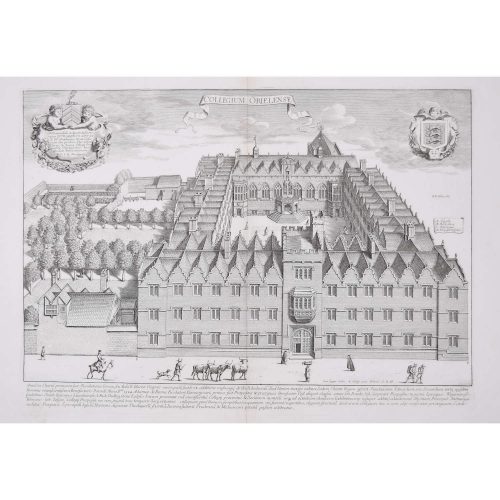
David Loggan (1634-1692)
Oriel College, Oxford (1674)
Engraving, 40 x 26.7cm Loggan was born to English and Scottish parents, and was baptised in Danzig in 1634. After studying engraving in Danzig with Willem Hondius (1598-1652 or 1658), he moved to London in the late 1650s, going on to produce the engraved title-page for the folio 1662 Book of Common Prayer. He married in 1663 and moved to Nuffield in Oxfordshire in 1665. Loggan was appointed Public Sculptor to the nearby University of Oxford in the late 1660s, having been commissioned to produce bird’s-eye views of all the Oxford colleges. He lived in Holywell Street as he did this. The 'Oxonia Illustrata' was published in 1675, with the help of Robert White (1645-1704). Following its completion, Loggan began work on his equivalent work for Cambridge; the 'Cantabrigia Illustrata' was finally published in 1690, when he was made engraver to Cambridge University. The 'Oxonia Illustrata' also includes an engraving of Winchester College (Winchester and New College share William of Wykeham as their founder) whilst the 'Cantabrigia Illustrata' includes one of Eton College (which shares its founder, Henry VIII, with King’s College). Bird’s-eye views from this era required a particular talent as an architectural perspectivist; it was not until 1783 that it became possible for artists to ascend via hot air balloons and view the scenes they were depicting from above. Loggan thus had to rely on his imagination in conceiving the views. Loggan’s views constitute the first accurate depictions of the two Universities, in many ways unchanged today. Whilst the Oxford engravings were produced in reasonable numbers and ran to a second edition by Henry Overton (on thicker paper and with a plate number in Roman numerals in the bottom right-hand corner), those of Cambridge were printed in much smaller numbers. The Dutchman Pieter van der Aa published some miniature versions of the engravings for James Beverell’s guidebook to the UK, 'Les Delices de la Grande Bretagne' (c. 1708). The contemporary artist Andrew Ingamells (b.1956) has produced a highly-acclaimed series of etchings which bring Loggan’s original vision up to date. Condition: generally very good. If you’d like to know more, please email info@manningfineart.co.uk or call us on 07929 749056. -
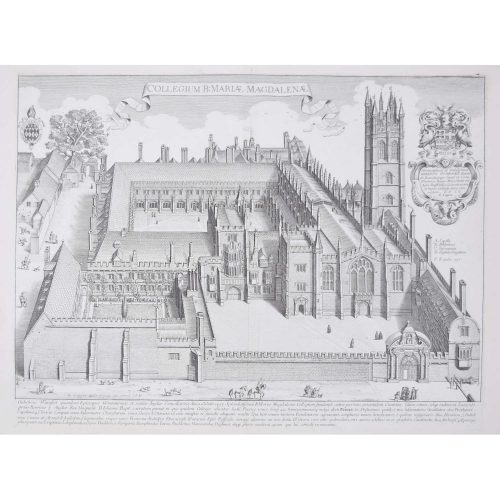
David Loggan (1634-1692)
Magdalen College, Oxford (1674)
Engraving, 32 x 42cm Loggan was born to English and Scottish parents, and was baptised in Danzig in 1634. After studying engraving in Danzig with Willem Hondius (1598-1652 or 1658), he moved to London in the late 1650s, going on to produce the engraved title-page for the folio 1662 Book of Common Prayer. He married in 1663 and moved to Nuffield in Oxfordshire in 1665. Loggan was appointed Public Sculptor to the nearby University of Oxford in the late 1660s, having been commissioned to produce bird’s-eye views of all the Oxford colleges. He lived in Holywell Street as he did this. The 'Oxonia Illustrata' was published in 1675, with the help of Robert White (1645-1704). Following its completion, Loggan began work on his equivalent work for Cambridge; the 'Cantabrigia Illustrata' was finally published in 1690, when he was made engraver to Cambridge University. The 'Oxonia Illustrata' also includes an engraving of Winchester College (Winchester and New College share William of Wykeham as their founder) whilst the 'Cantabrigia Illustrata' includes one of Eton College (which shares its founder, Henry VIII, with King’s College). Bird’s-eye views from this era required a particular talent as an architectural perspectivist; it was not until 1783 that it became possible for artists to ascend via hot air balloons and view the scenes they were depicting from above. Loggan thus had to rely on his imagination in conceiving the views. Loggan’s views constitute the first accurate depictions of the two Universities, in many ways unchanged today. Whilst the Oxford engravings were produced in reasonable numbers and ran to a second edition by Henry Overton (on thicker paper and with a plate number in Roman numerals in the bottom right-hand corner), those of Cambridge were printed in much smaller numbers. The Dutchman Pieter van der Aa published some miniature versions of the engravings for James Beverell’s guidebook to the UK, 'Les Delices de la Grande Bretagne' (c. 1708). The contemporary artist Andrew Ingamells (b.1956) has produced a highly-acclaimed series of etchings which bring Loggan’s original vision up to date. Condition: generally very good. If you’d like to know more, please email info@manningfineart.co.uk or call us on 07929 749056. -
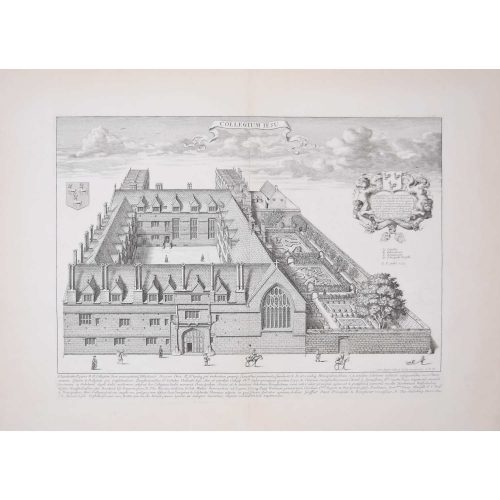
David Loggan (1634-1692)
Jesus College, Oxford
Engraving, 1675 30 x 41cm Loggan was born to English and Scottish parents, and was baptised in Danzig in 1634. After studying engraving in Danzig with Willem Hondius (1598-1652 or 1658), he moved to London in the late 1650s, going on to produce the engraved title-page for the folio 1662 Book of Common Prayer. He married in 1663 and moved to Nuffield in Oxfordshire in 1665. Loggan was appointed Public Sculptor to the nearby University of Oxford in the late 1660s, having been commissioned to produce bird’s-eye views of all the Oxford colleges. He lived in Holywell Street as he did this. The 'Oxonia Illustrata' was published in 1675, with the help of Robert White (1645-1704). Following its completion, Loggan began work on his equivalent work for Cambridge; the 'Cantabrigia Illustrata' was finally published in 1690, when he was made engraver to Cambridge University. The 'Oxonia Illustrata' also includes an engraving of Winchester College (Winchester and New College share William of Wykeham as their founder) whilst the 'Cantabrigia Illustrata' includes one of Eton College (which shares its founder, Henry VIII, with King’s College). Bird’s-eye views from this era required a particular talent as an architectural perspectivist; it was not until 1783 that it became possible for artists to ascend via hot air balloons and view the scenes they were depicting from above. Loggan thus had to rely on his imagination in conceiving the views. Loggan’s views constitute the first accurate depictions of the two Universities, in many ways unchanged today. Whilst the Oxford engravings were produced in reasonable numbers and ran to a second edition by Henry Overton (on thicker paper and with a plate number in Roman numerals in the bottom right-hand corner), those of Cambridge were printed in much smaller numbers. The Dutchman Pieter van der Aa published some miniature versions of the engravings for James Beverell’s guidebook to the UK, 'Les Delices de la Grande Bretagne' (c. 1708). The contemporary artist Andrew Ingamells (b.1956) has produced a highly-acclaimed series of etchings which bring Loggan’s original vision up to date. Condition: excellent. If you’d like to know more, please email info@manningfineart.co.uk or call us on 07929 749056. -
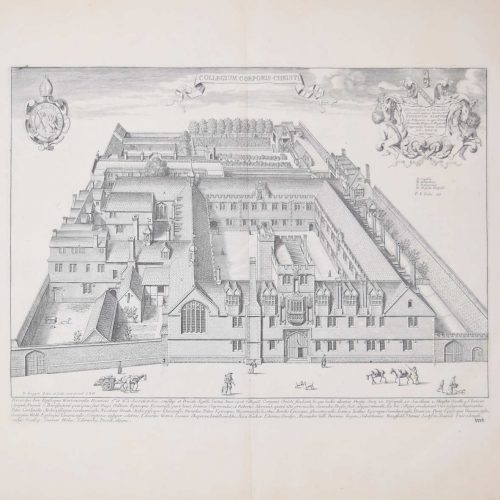 David Loggan (1634-1692) Corpus Christi College, Oxford Engraving, 1675 30x41cm Loggan was born to English and Scottish parents, and was baptised in Danzig in 1634. After studying engraving in Danzig with Willem Hondius (1598-1652 or 1658), he moved to London in the late 1650s, going on to produce the engraved title-page for the folio 1662 Book of Common Prayer. He married in 1663 and moved to Nuffield in Oxfordshire in 1665. Loggan was appointed Public Sculptor to the nearby University of Oxford in the late 1660s, having been commissioned to produce bird’s-eye views of all the Oxford colleges. He lived in Holywell Street as he did this. The 'Oxonia Illustrata' was published in 1675, with the help of Robert White (1645-1704). Following its completion, Loggan began work on his equivalent work for Cambridge; the 'Cantabrigia Illustrata' was finally published in 1690, when he was made engraver to Cambridge University. The 'Oxonia Illustrata' also includes an engraving of Winchester College (Winchester and New College share William of Wykeham as their founder) whilst the 'Cantabrigia Illustrata' includes one of Eton College (which shares its founder, Henry VIII, with King’s College). Bird’s-eye views from this era required a particular talent as an architectural perspectivist; it was not until 1783 that it became possible for artists to ascend via hot air balloons and view the scenes they were depicting from above. Loggan thus had to rely on his imagination in conceiving the views. Loggan’s views constitute the first accurate depictions of the two Universities, in many ways unchanged today. Whilst the Oxford engravings were produced in reasonable numbers and ran to a second edition by Henry Overton (on thicker paper and with a plate number in Roman numerals in the bottom right-hand corner), those of Cambridge were printed in much smaller numbers. The Dutchman Pieter van der Aa published some miniature versions of the engravings for James Beverell’s guidebook to the UK, 'Les Delices de la Grande Bretagne' (c. 1708). The contemporary artist Andrew Ingamells (b.1956) has produced a highly-acclaimed series of etchings which bring Loggan’s original vision up to date. If you’d like to know more, please email info@manningfineart.co.uk or call us on 07929 749056. Condition: Good, some spots, repair to central fold.
David Loggan (1634-1692) Corpus Christi College, Oxford Engraving, 1675 30x41cm Loggan was born to English and Scottish parents, and was baptised in Danzig in 1634. After studying engraving in Danzig with Willem Hondius (1598-1652 or 1658), he moved to London in the late 1650s, going on to produce the engraved title-page for the folio 1662 Book of Common Prayer. He married in 1663 and moved to Nuffield in Oxfordshire in 1665. Loggan was appointed Public Sculptor to the nearby University of Oxford in the late 1660s, having been commissioned to produce bird’s-eye views of all the Oxford colleges. He lived in Holywell Street as he did this. The 'Oxonia Illustrata' was published in 1675, with the help of Robert White (1645-1704). Following its completion, Loggan began work on his equivalent work for Cambridge; the 'Cantabrigia Illustrata' was finally published in 1690, when he was made engraver to Cambridge University. The 'Oxonia Illustrata' also includes an engraving of Winchester College (Winchester and New College share William of Wykeham as their founder) whilst the 'Cantabrigia Illustrata' includes one of Eton College (which shares its founder, Henry VIII, with King’s College). Bird’s-eye views from this era required a particular talent as an architectural perspectivist; it was not until 1783 that it became possible for artists to ascend via hot air balloons and view the scenes they were depicting from above. Loggan thus had to rely on his imagination in conceiving the views. Loggan’s views constitute the first accurate depictions of the two Universities, in many ways unchanged today. Whilst the Oxford engravings were produced in reasonable numbers and ran to a second edition by Henry Overton (on thicker paper and with a plate number in Roman numerals in the bottom right-hand corner), those of Cambridge were printed in much smaller numbers. The Dutchman Pieter van der Aa published some miniature versions of the engravings for James Beverell’s guidebook to the UK, 'Les Delices de la Grande Bretagne' (c. 1708). The contemporary artist Andrew Ingamells (b.1956) has produced a highly-acclaimed series of etchings which bring Loggan’s original vision up to date. If you’d like to know more, please email info@manningfineart.co.uk or call us on 07929 749056. Condition: Good, some spots, repair to central fold. -
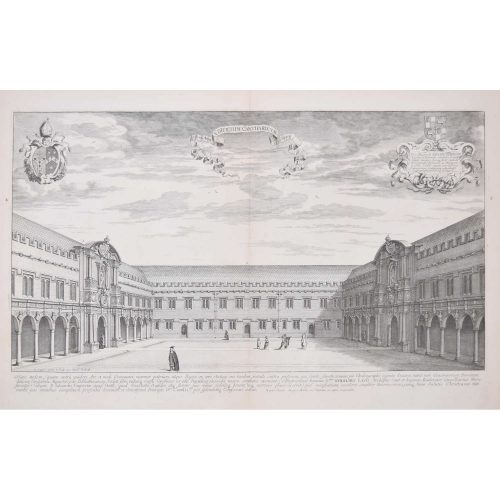
David Loggan (1634-1692)
Canterbury Quad, St John's College, Oxford
Engraving, 1675 32 x 51cm Loggan was born to English and Scottish parents, and was baptised in Danzig in 1634. After studying engraving in Danzig with Willem Hondius (1598-1652 or 1658), he moved to London in the late 1650s, going on to produce the engraved title-page for the folio 1662 Book of Common Prayer. He married in 1663 and moved to Nuffield in Oxfordshire in 1665. Loggan was appointed Public Sculptor to the nearby University of Oxford in the late 1660s, having been commissioned to produce bird’s-eye views of all the Oxford colleges. He lived in Holywell Street as he did this. The 'Oxonia Illustrata' was published in 1675, with the help of Robert White (1645-1704). Following its completion, Loggan began work on his equivalent work for Cambridge; the 'Cantabrigia Illustrata' was finally published in 1690, when he was made engraver to Cambridge University. The 'Oxonia Illustrata' also includes an engraving of Winchester College (Winchester and New College share William of Wykeham as their founder) whilst the 'Cantabrigia Illustrata' includes one of Eton College (which shares its founder, Henry VIII, with King’s College). Bird’s-eye views from this era required a particular talent as an architectural perspectivist; it was not until 1783 that it became possible for artists to ascend via hot air balloons and view the scenes they were depicting from above. Loggan thus had to rely on his imagination in conceiving the views. Loggan’s views constitute the first accurate depictions of the two Universities, in many ways unchanged today. Whilst the Oxford engravings were produced in reasonable numbers and ran to a second edition by Henry Overton (on thicker paper and with a plate number in Roman numerals in the bottom right-hand corner), those of Cambridge were printed in much smaller numbers. The Dutchman Pieter van der Aa published some miniature versions of the engravings for James Beverell’s guidebook to the UK, 'Les Delices de la Grande Bretagne' (c. 1708). The contemporary artist Andrew Ingamells (b.1956) has produced a highly-acclaimed series of etchings which bring Loggan’s original vision up to date. Condition: excellent. If you’d like to know more, please email info@manningfineart.co.uk or call us on 07929 749056. -
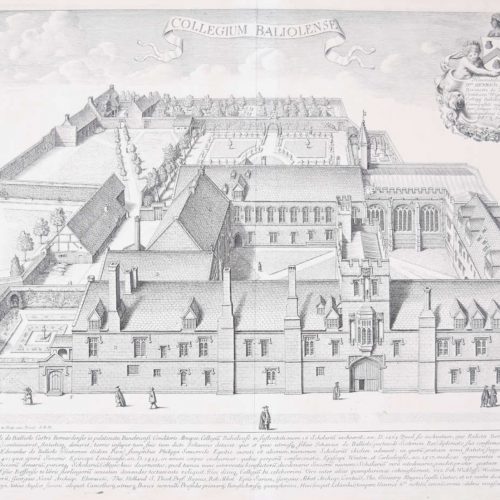
David Loggan (1634-1692)
Balliol College, Oxford
Engraving, 1675 30x40cm Loggan was born to English and Scottish parents, and was baptised in Danzig in 1634. After studying engraving in Danzig with Willem Hondius (1598-1652 or 1658), he moved to London in the late 1650s, going on to produce the engraved title-page for the folio 1662 Book of Common Prayer. He married in 1663 and moved to Nuffield in Oxfordshire in 1665. Loggan was appointed Public Sculptor to the nearby University of Oxford in the late 1660s, having been commissioned to produce bird’s-eye views of all the Oxford colleges. He lived in Holywell Street as he did this. The 'Oxonia Illustrata' was published in 1675, with the help of Robert White (1645-1704). Following its completion, Loggan began work on his equivalent work for Cambridge; the 'Cantabrigia Illustrata' was finally published in 1690, when he was made engraver to Cambridge University. The 'Oxonia Illustrata' also includes an engraving of Winchester College (Winchester and New College share William of Wykeham as their founder) whilst the 'Cantabrigia Illustrata' includes one of Eton College (which shares its founder, Henry VIII, with King’s College). Bird’s-eye views from this era required a particular talent as an architectural perspectivist; it was not until 1783 that it became possible for artists to ascend via hot air balloons and view the scenes they were depicting from above. Loggan thus had to rely on his imagination in conceiving the views. Loggan’s views constitute the first accurate depictions of the two Universities, in many ways unchanged today. Whilst the Oxford engravings were produced in reasonable numbers and ran to a second edition by Henry Overton (on thicker paper and with a plate number in Roman numerals in the bottom right-hand corner), those of Cambridge were printed in much smaller numbers. The Dutchman Pieter van der Aa published some miniature versions of the engravings for James Beverell’s guidebook to the UK, 'Les Delices de la Grande Bretagne' (c. 1708). The contemporary artist Andrew Ingamells (b.1956) has produced a highly-acclaimed series of etchings which bring Loggan’s original vision up to date. If you’d like to know more, please email info@manningfineart.co.uk or call us on 07929 749056. Condition: Generally good. -
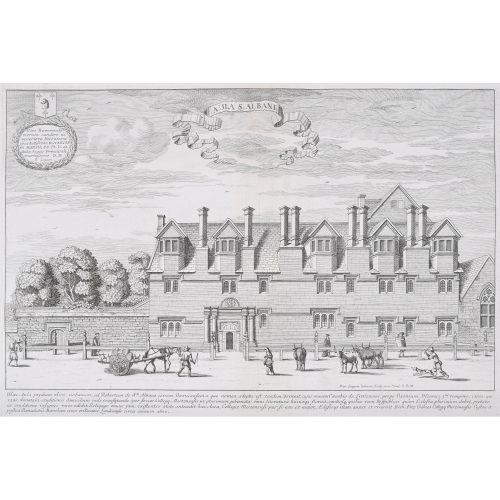
David Loggan (1634-1692)
St Alban's Hall, Oxford
Engraving, 1675 25x35cm Now a part of Merton College For biographical details and other works by the artist click here. If you are interested email info@manningfineart.co.uk or call us on 07929 749056. -
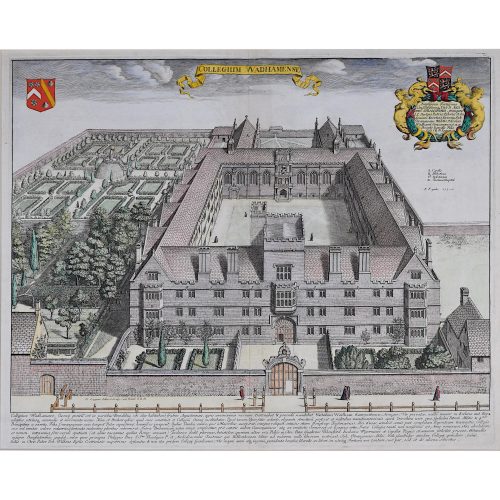
David Loggan (1634-1692)
Wadham College Oxford
Engraving (1675) with later hand colouring. 34x42cm If you are interested email info@manningfineart.co.uk or call us on 07929 749056. -
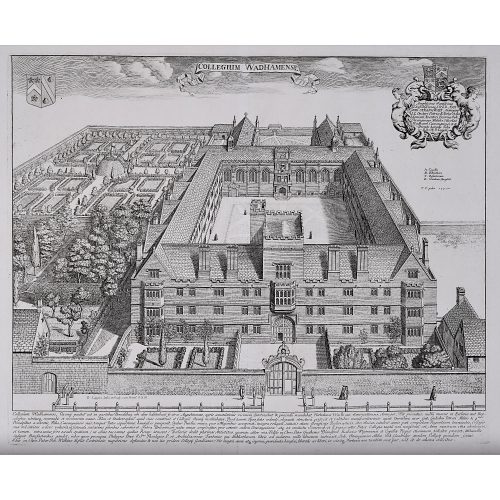
David Loggan (1634-1692)
Wadham College Oxford
Engraving (1675) 34x42cm If you are interested email info@manningfineart.co.uk or call us on 07929 749056. -
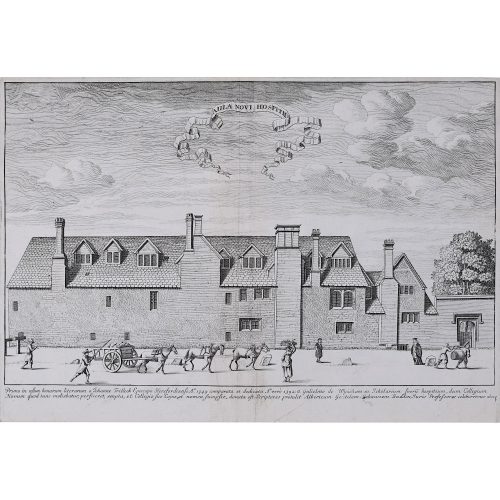
David Loggan (1634-1692)
Aula Novi Hospitii
Engraving, 1675 25x36cm If you are interested email info@manningfineart.co.uk or call us on 07929 749056. -
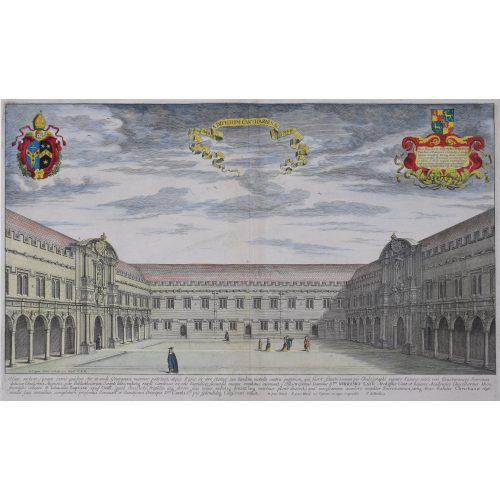
David Loggan (1634-1692)
St John's College Oxford, Canterbury Quad
Engraving (1675) with later hand colouring 31x50cm If you are interested email info@manningfineart.co.uk or call us on 07929 749056. -
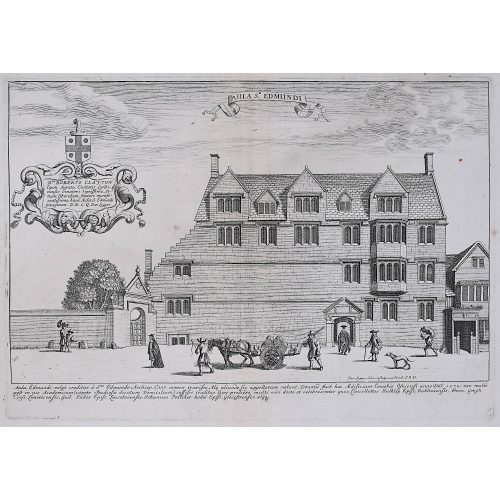
David Loggan (1634-1692)
St Edmund Hall Oxford
Engraving (1675) 25x35cm If you are interested email info@manningfineart.co.uk or call us on 07929 749056.

